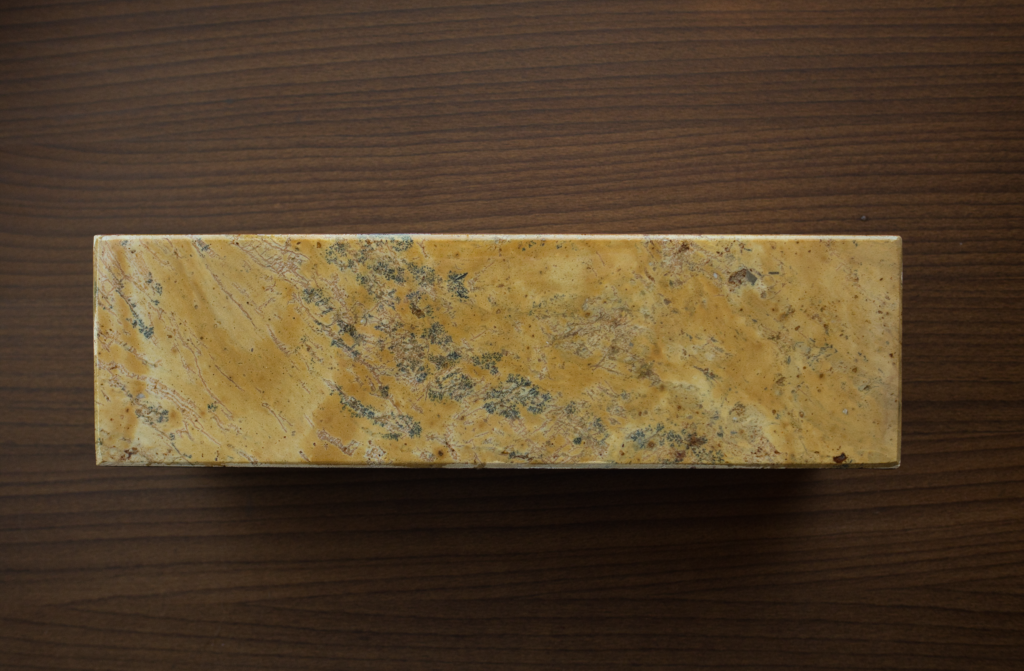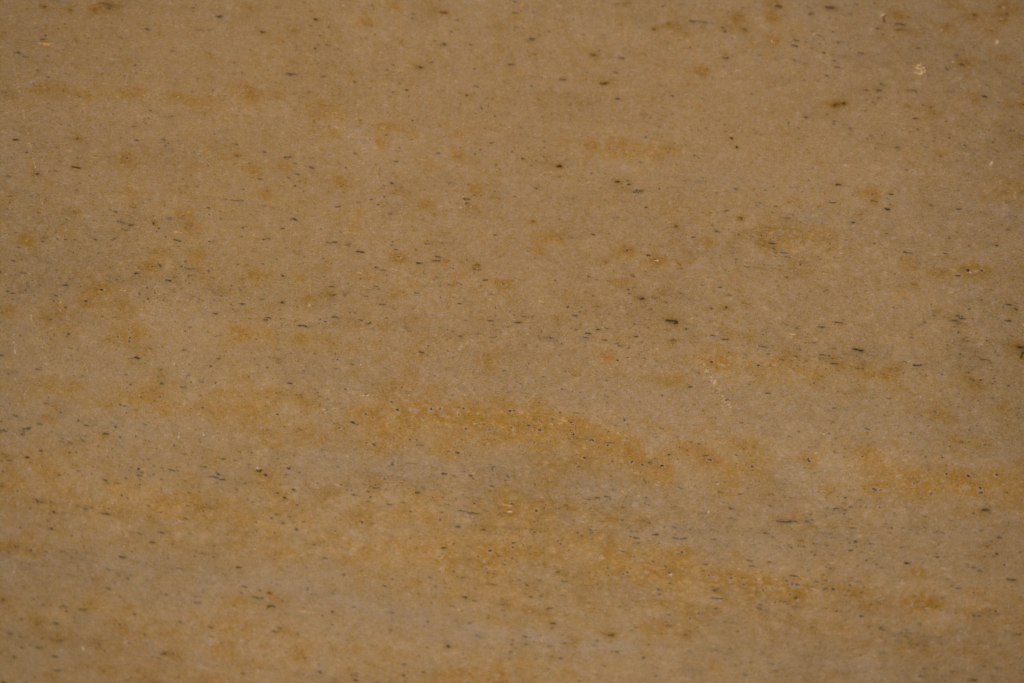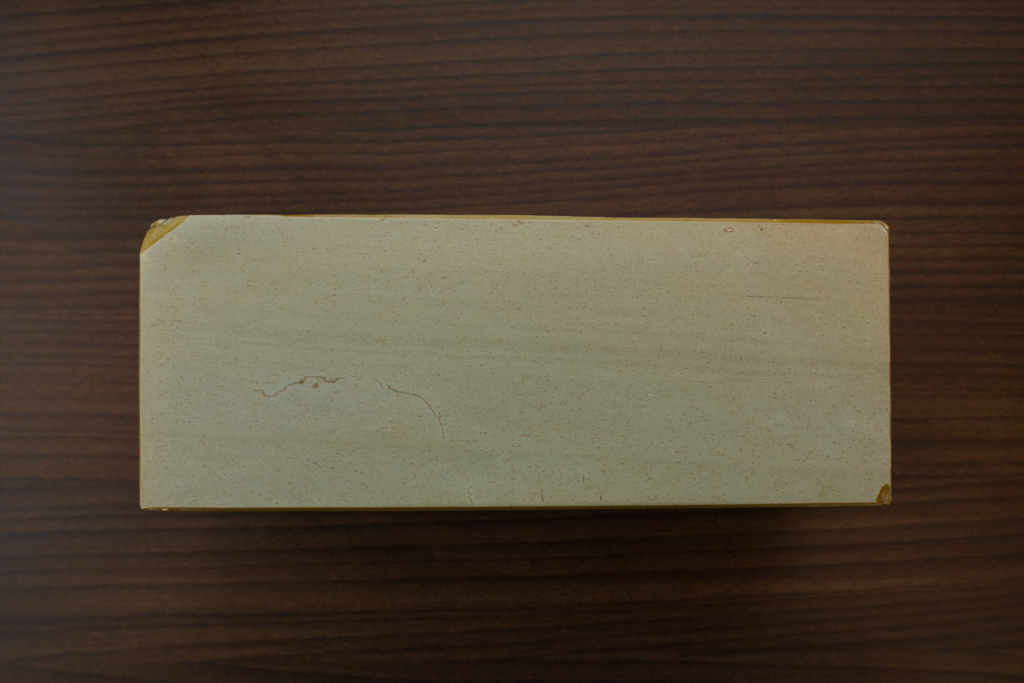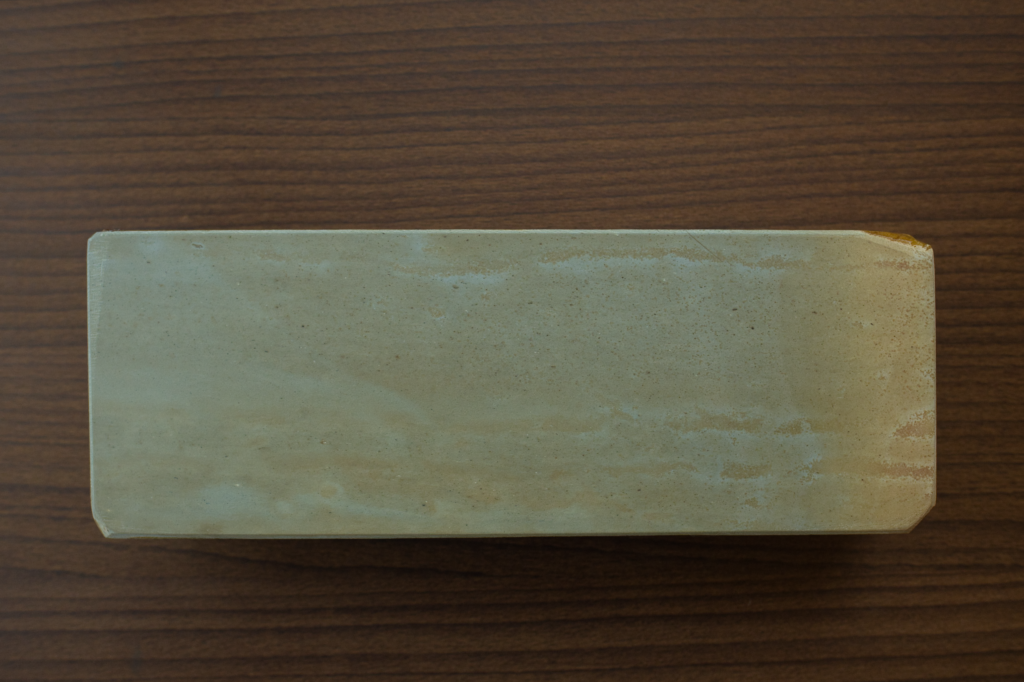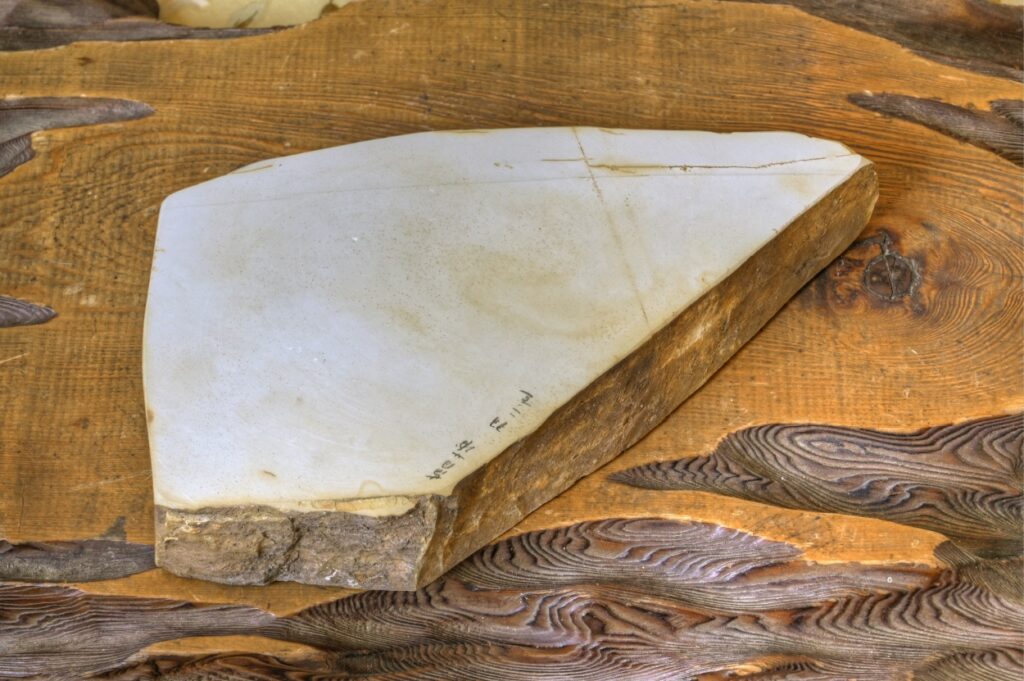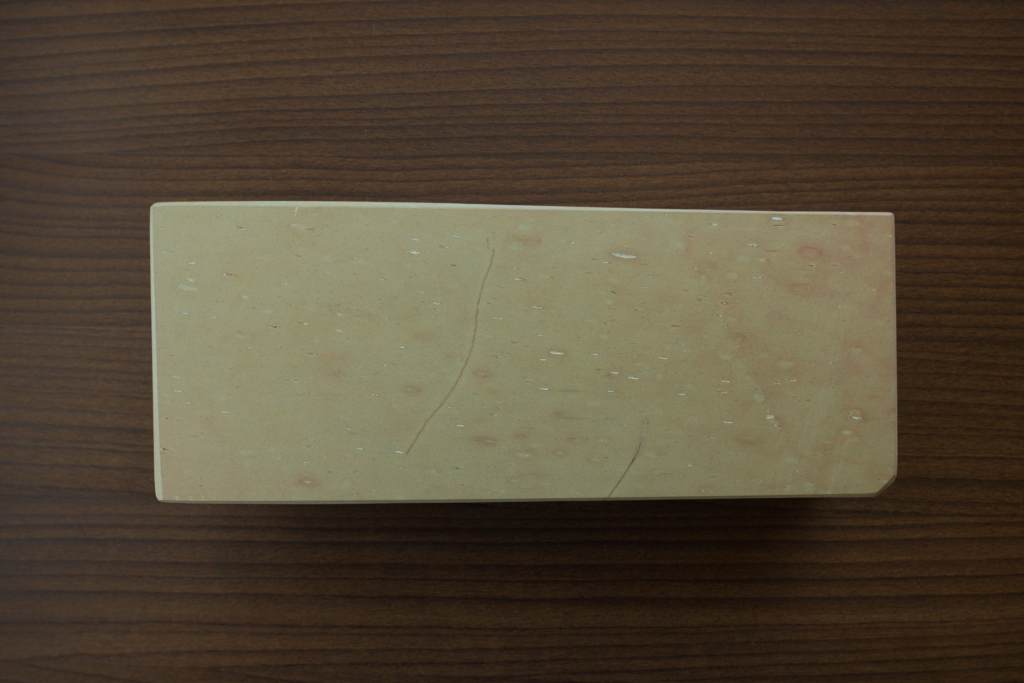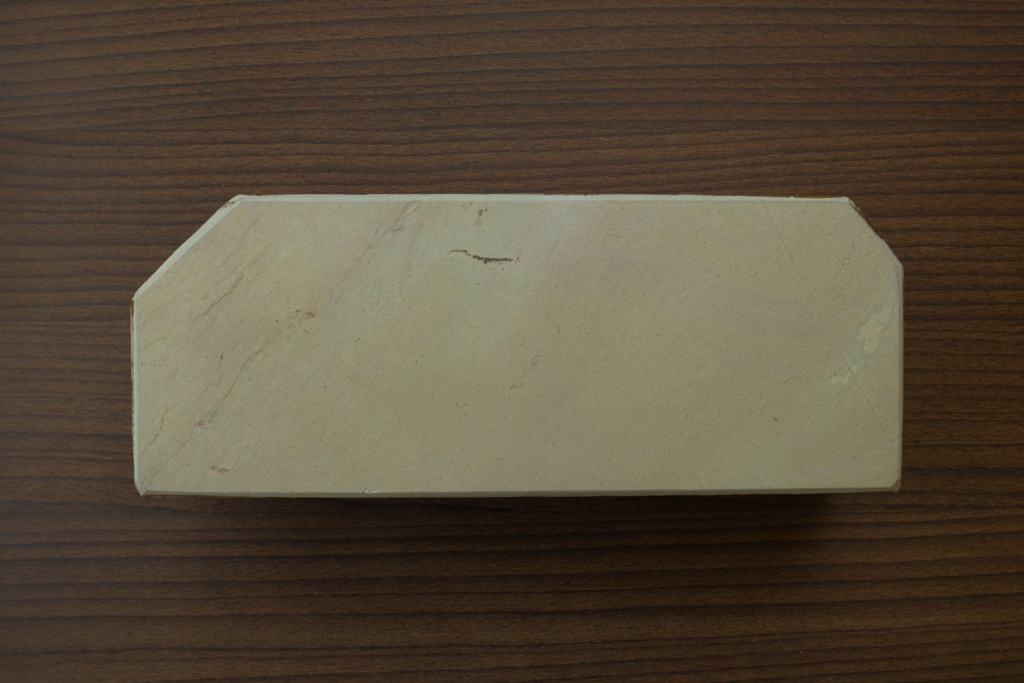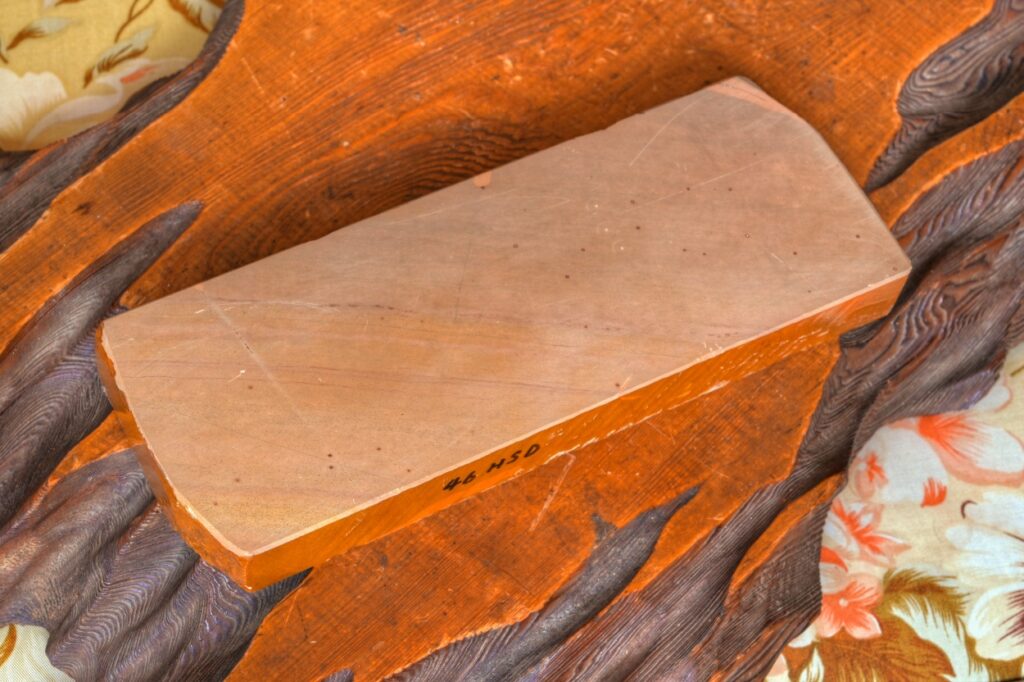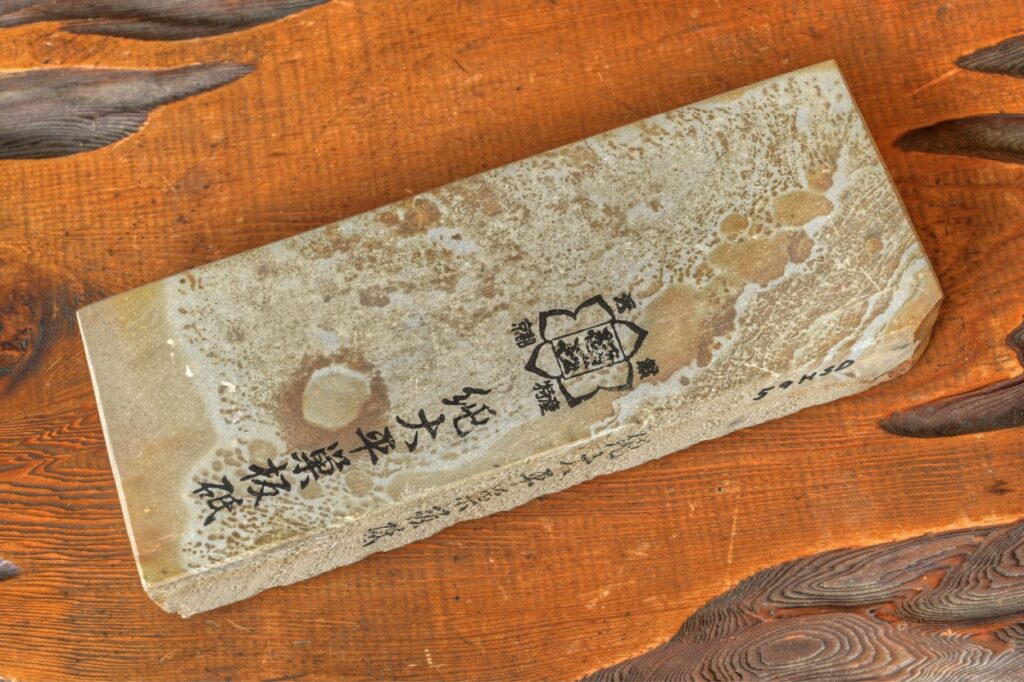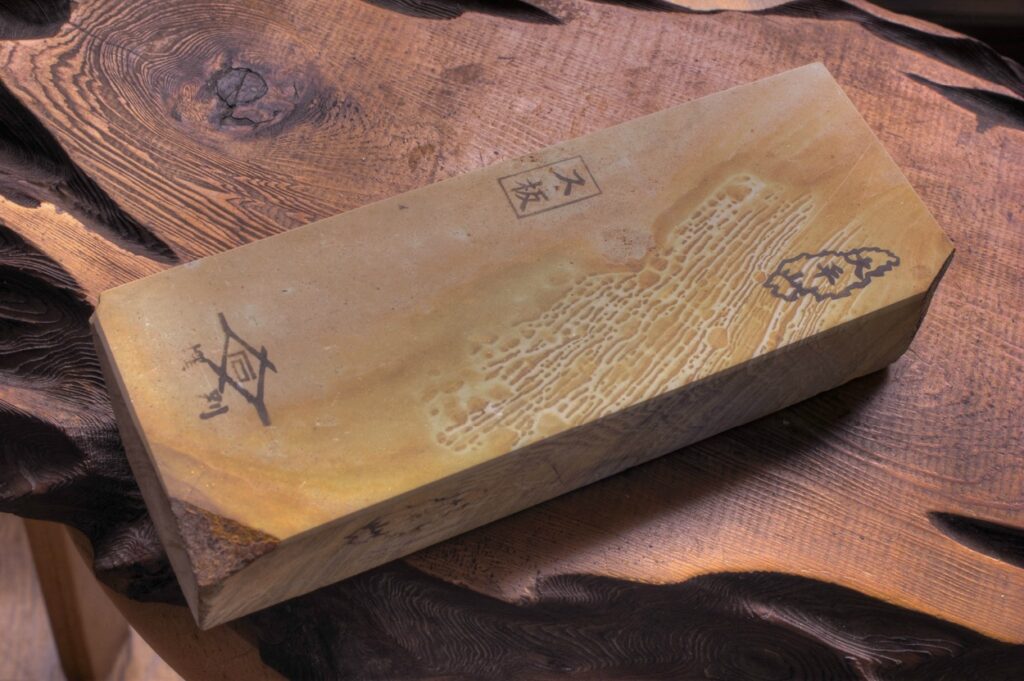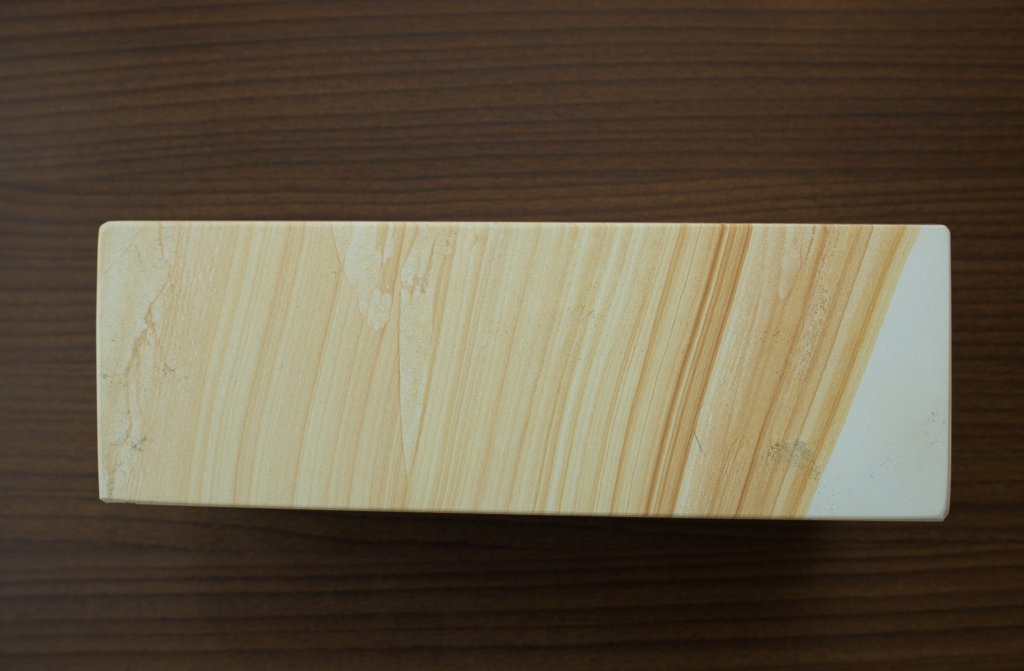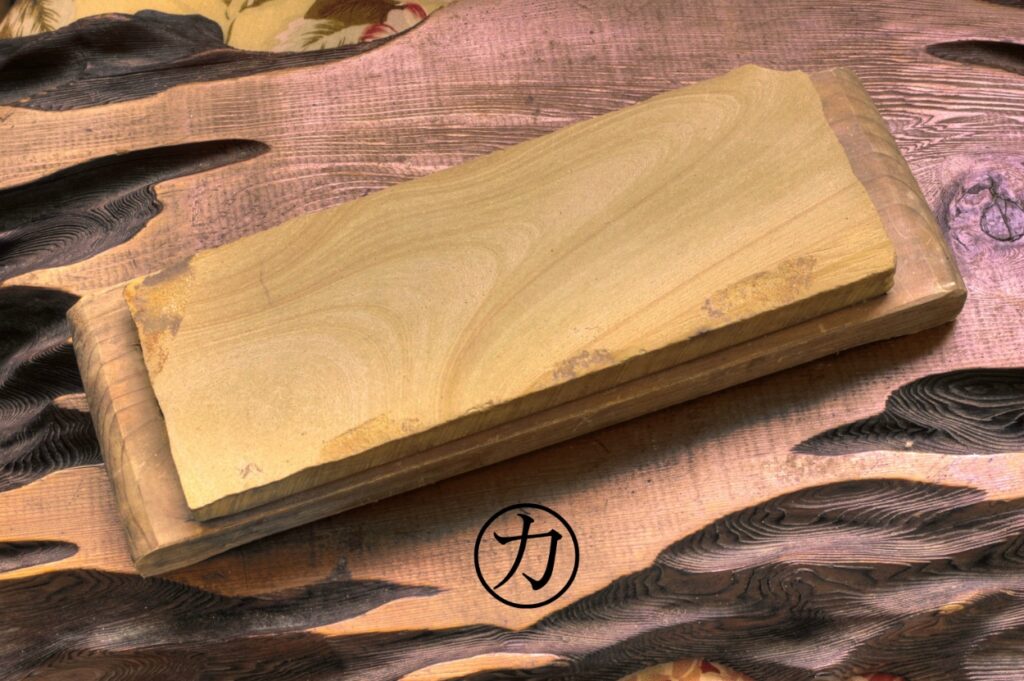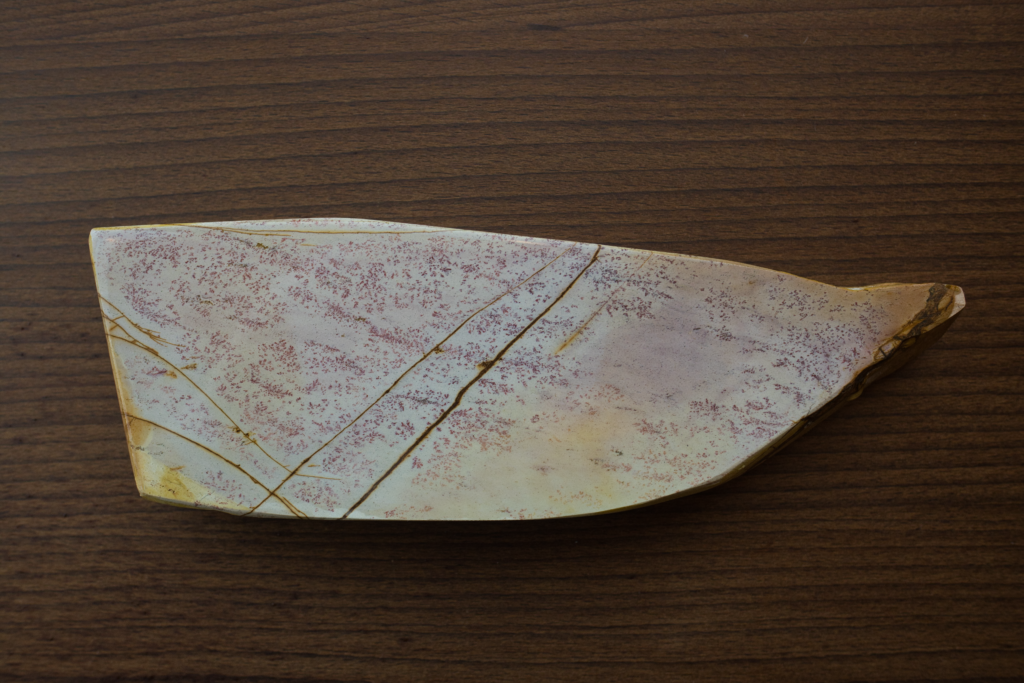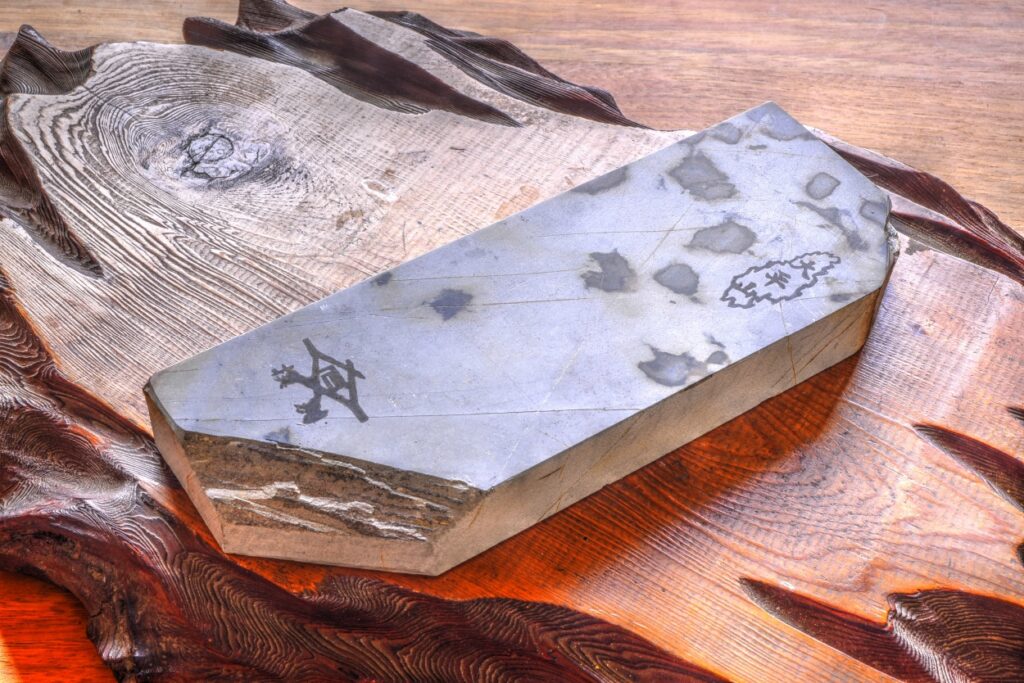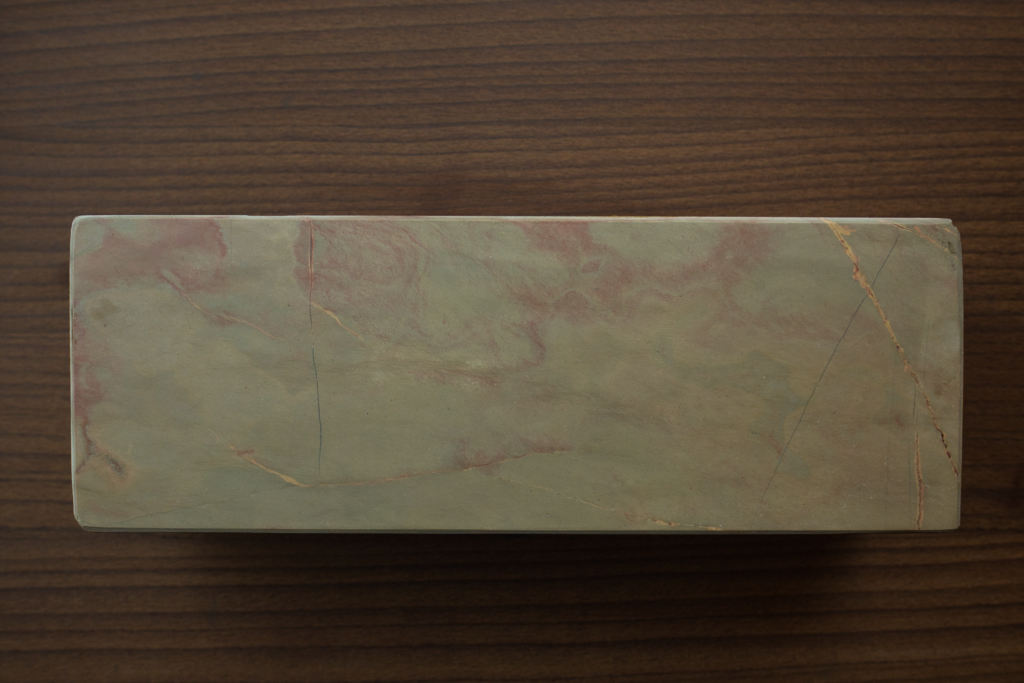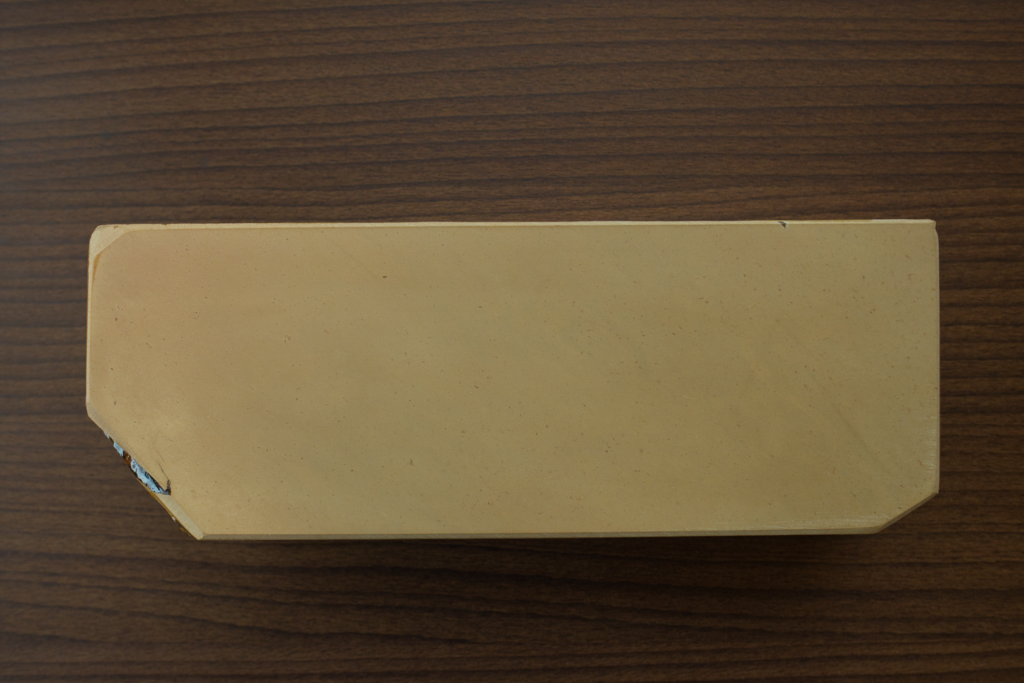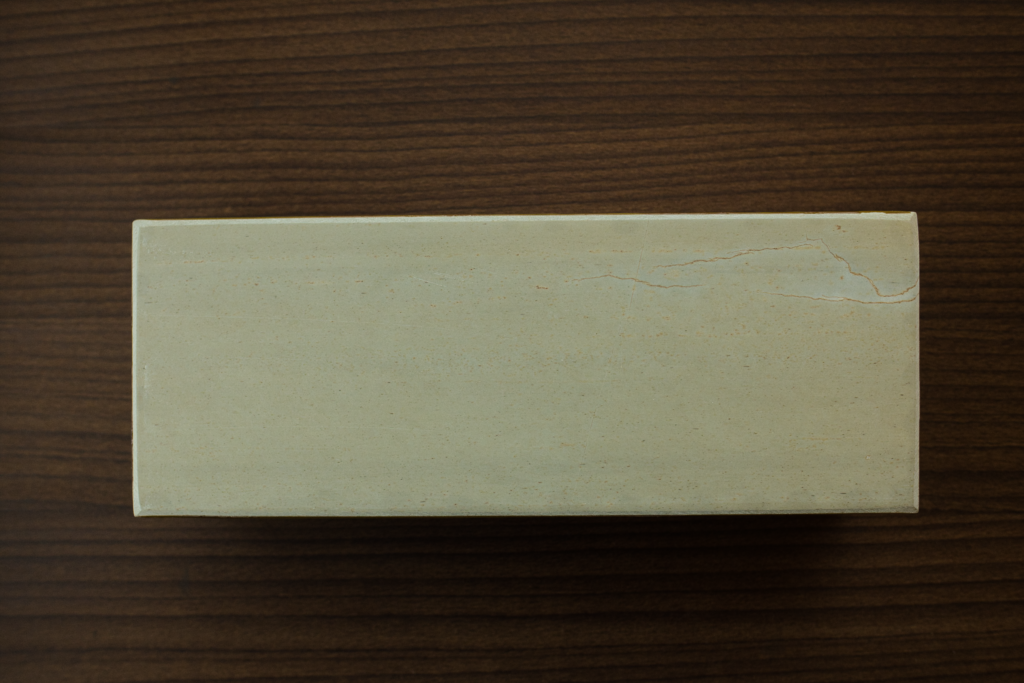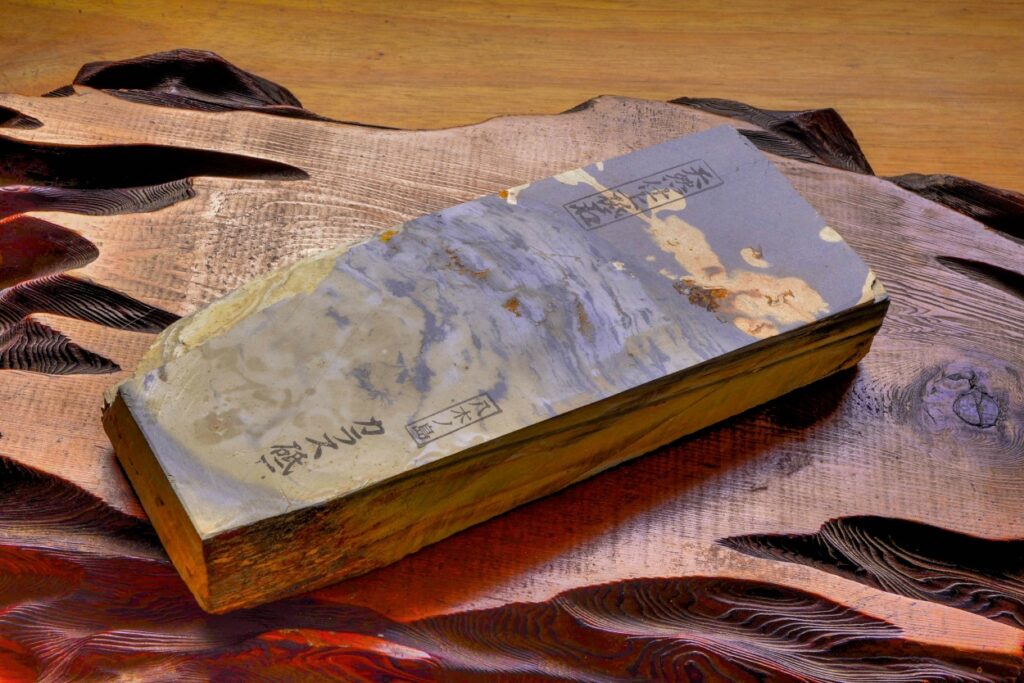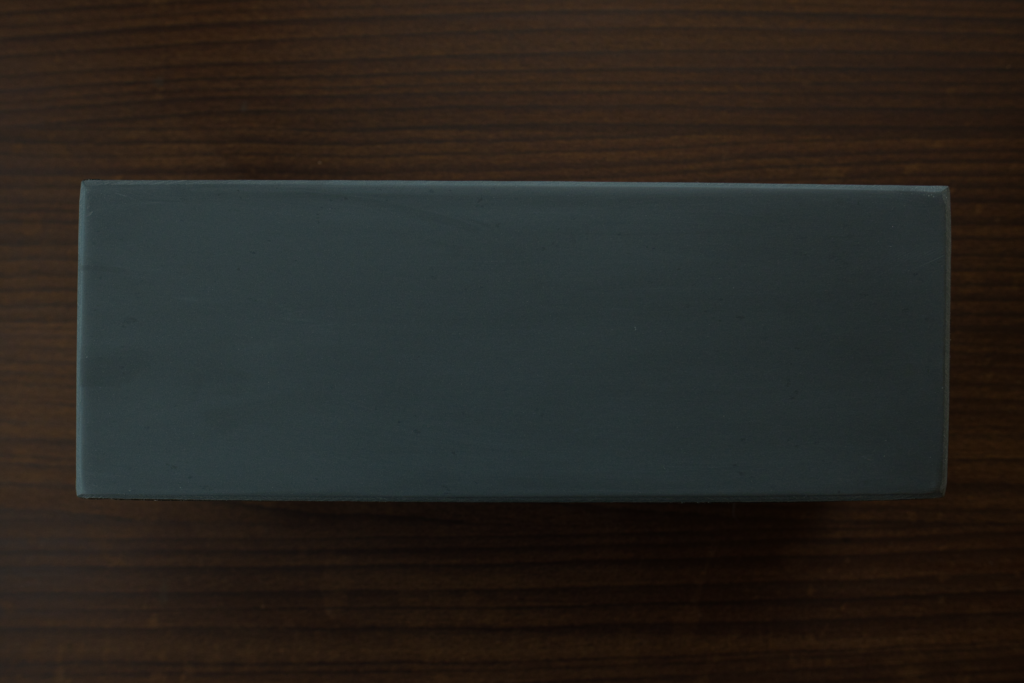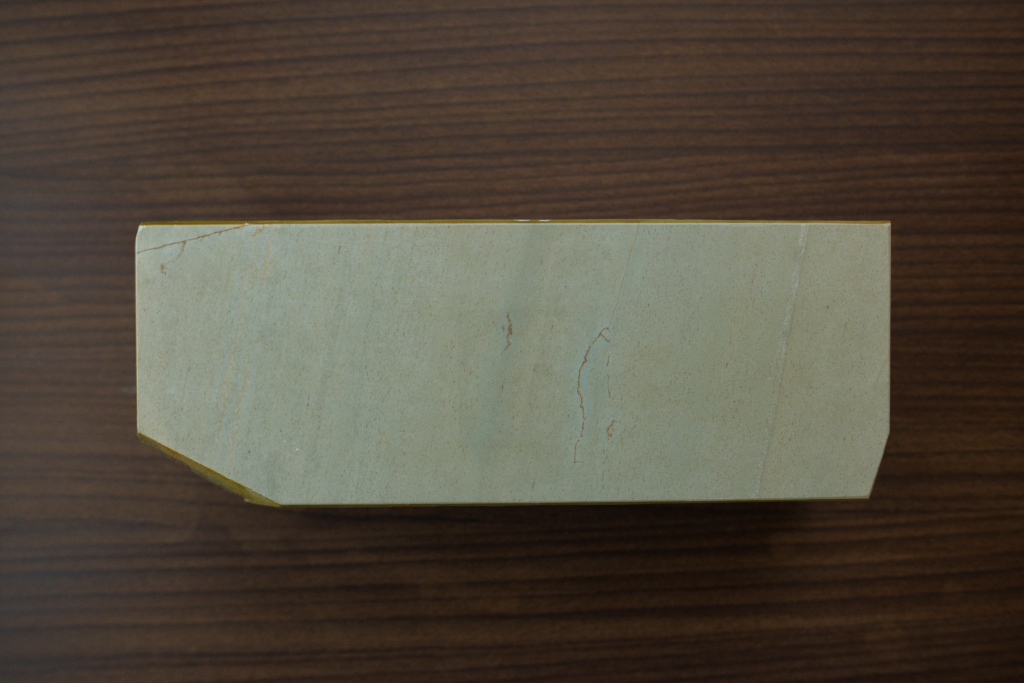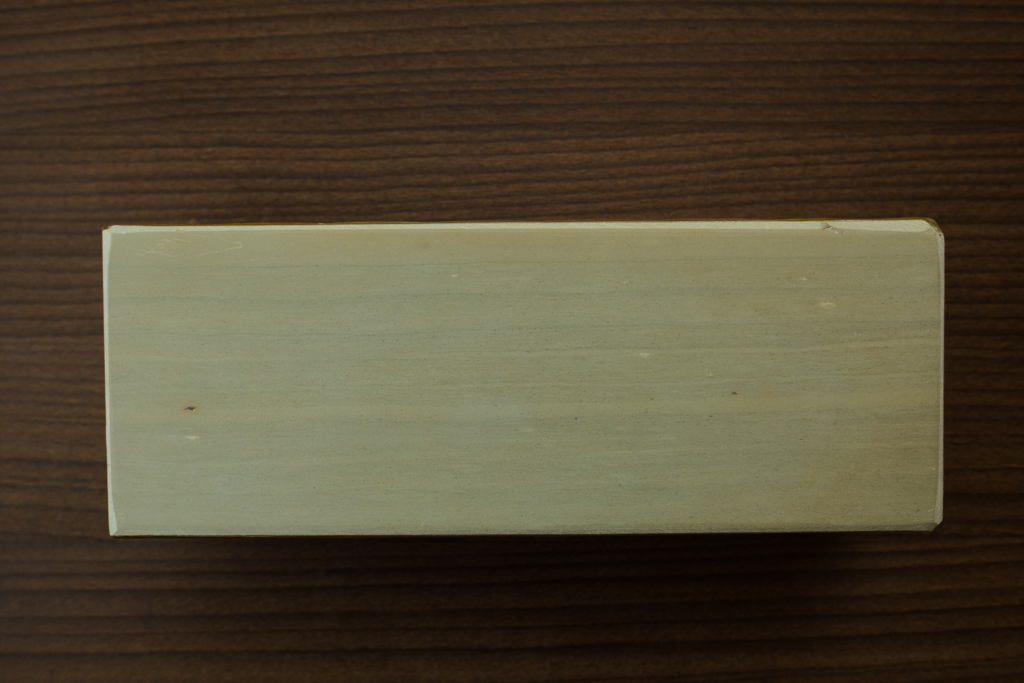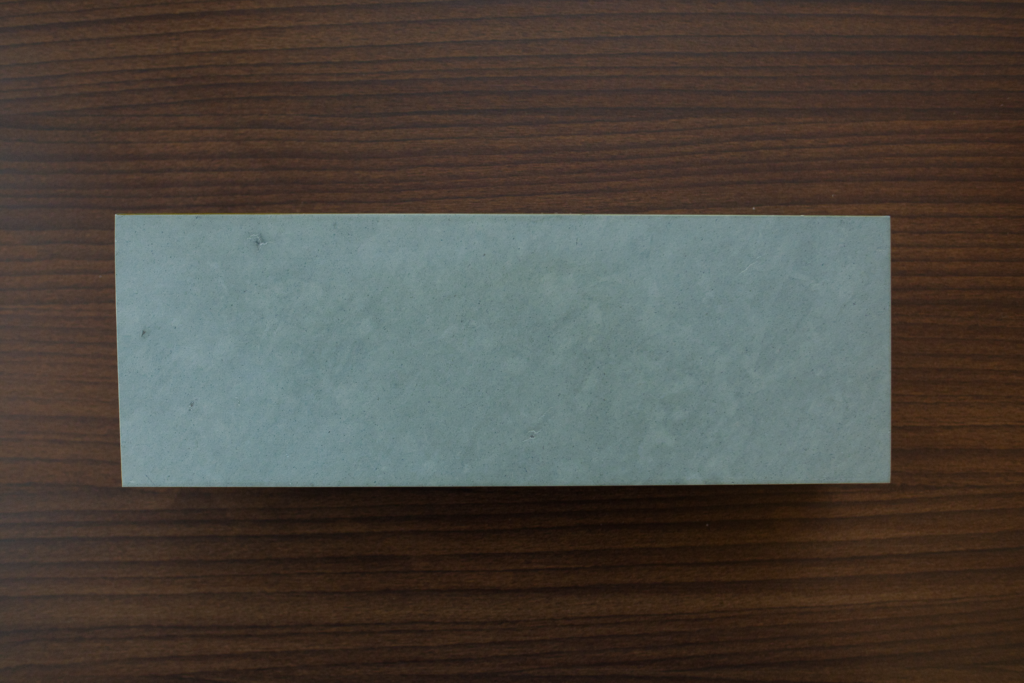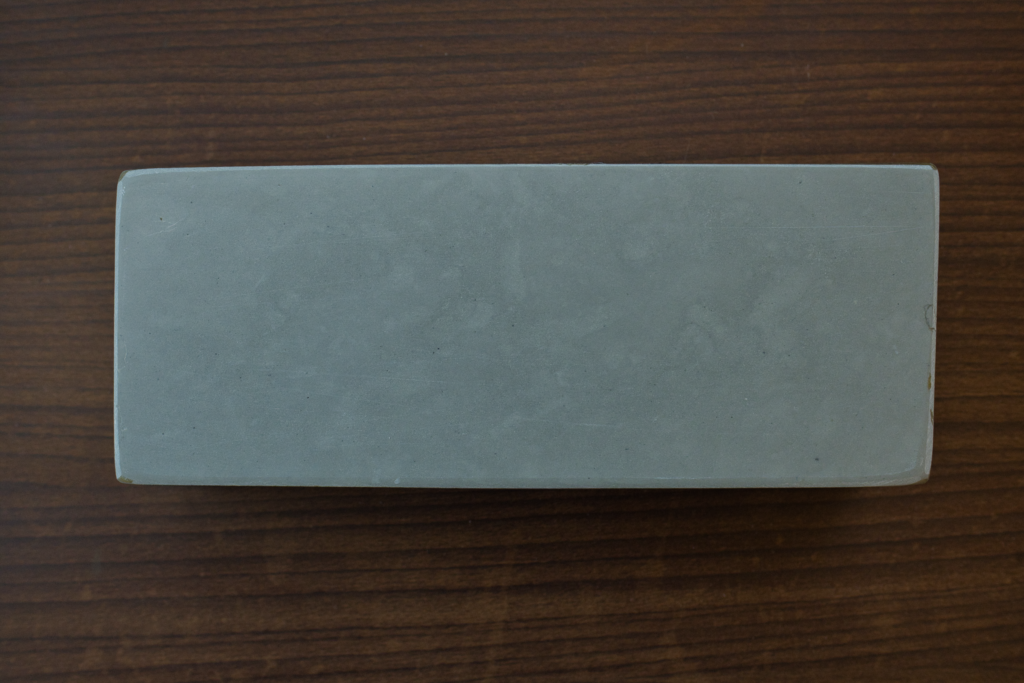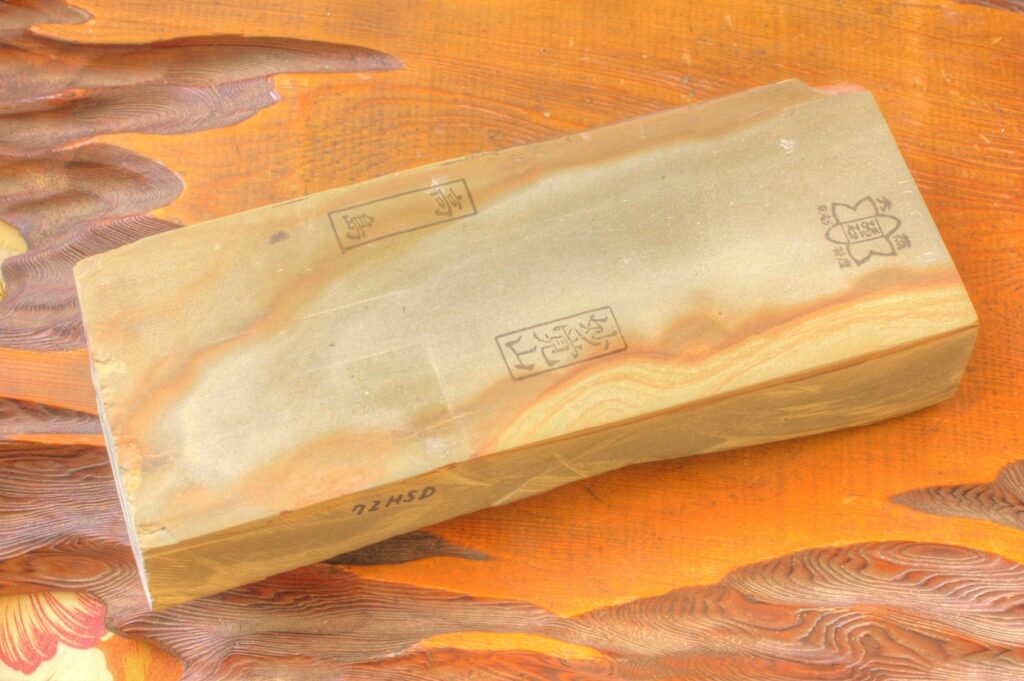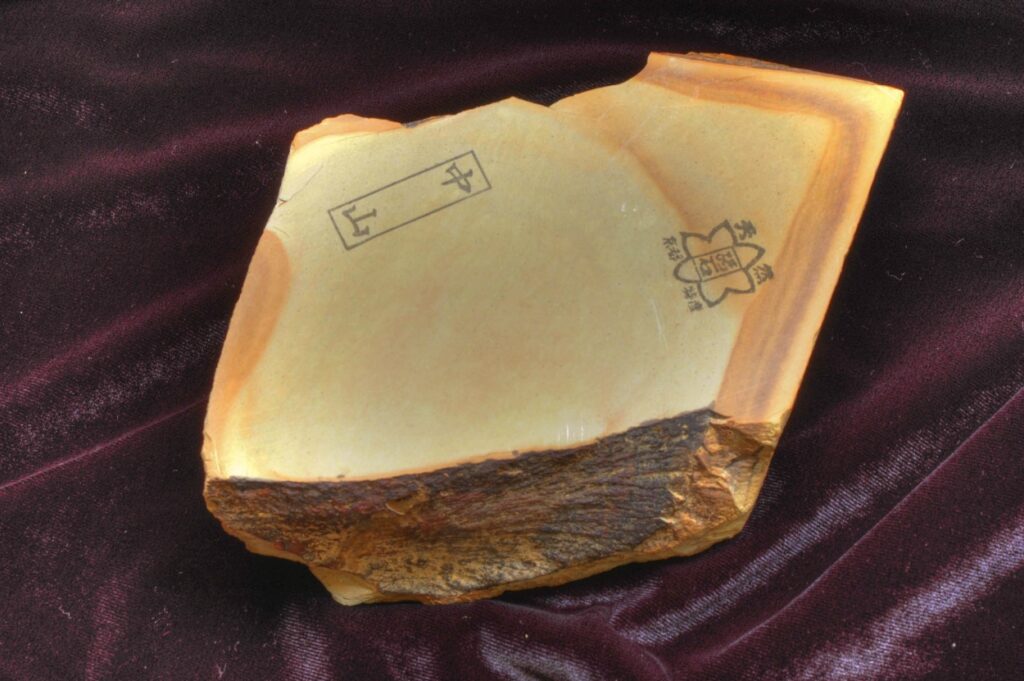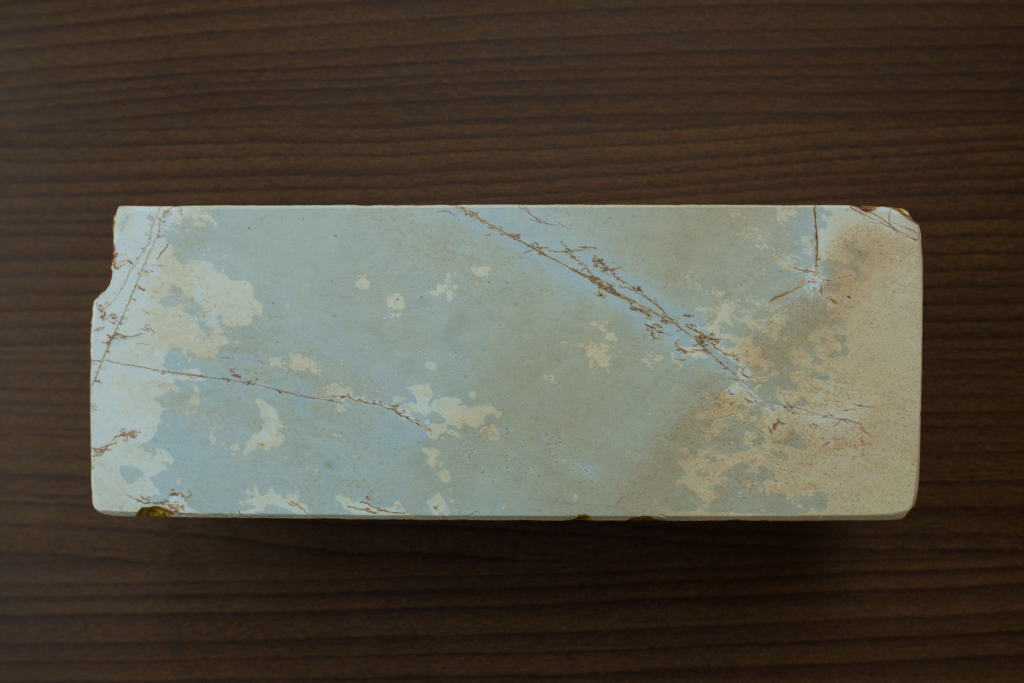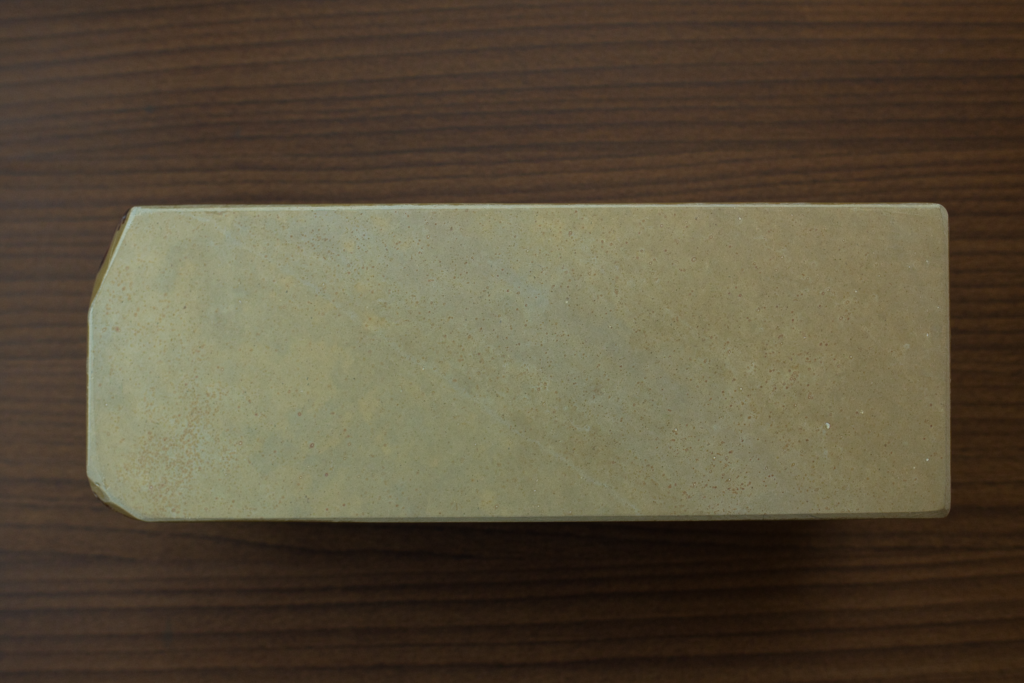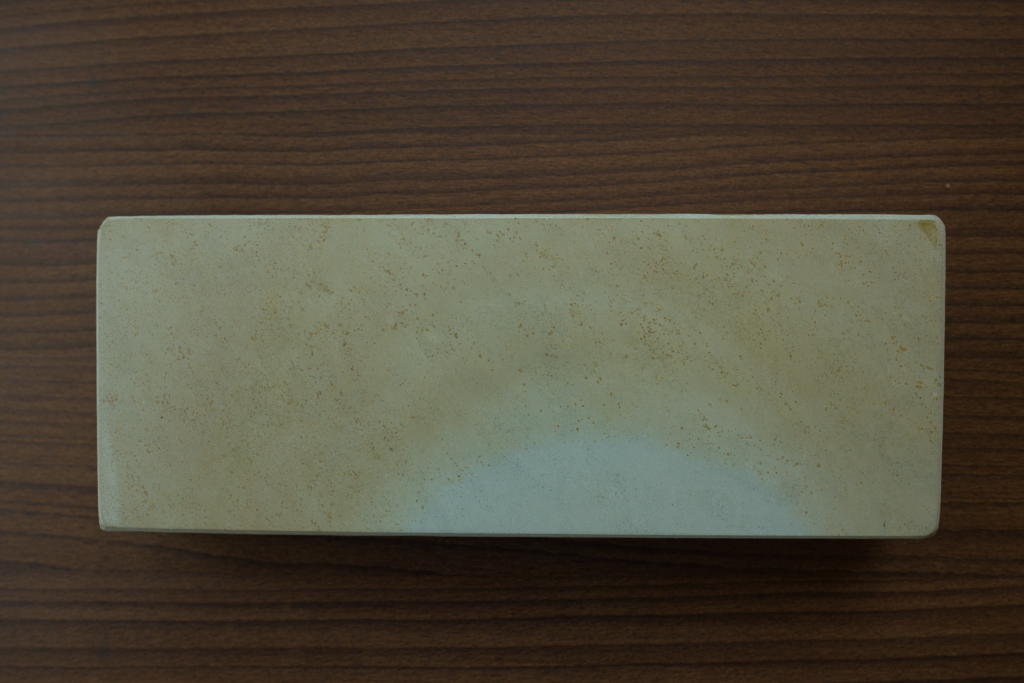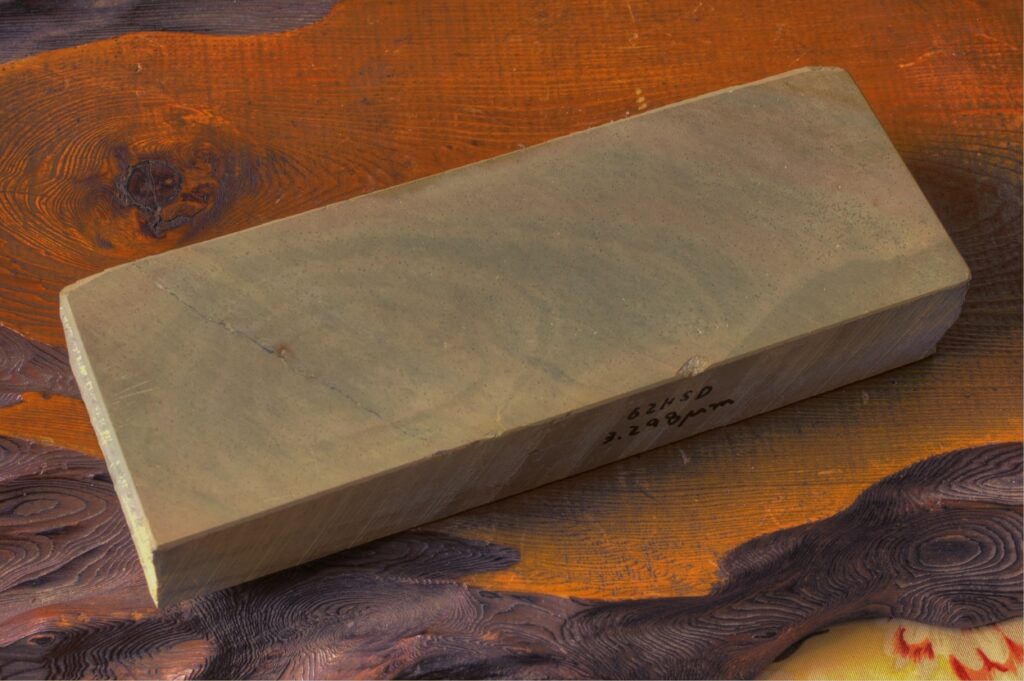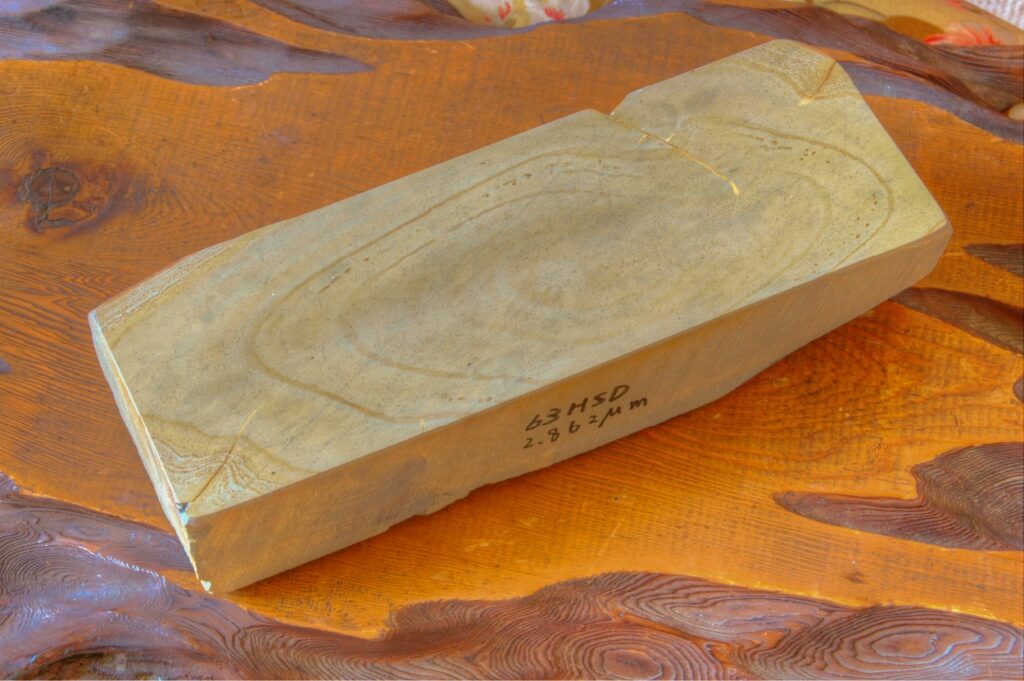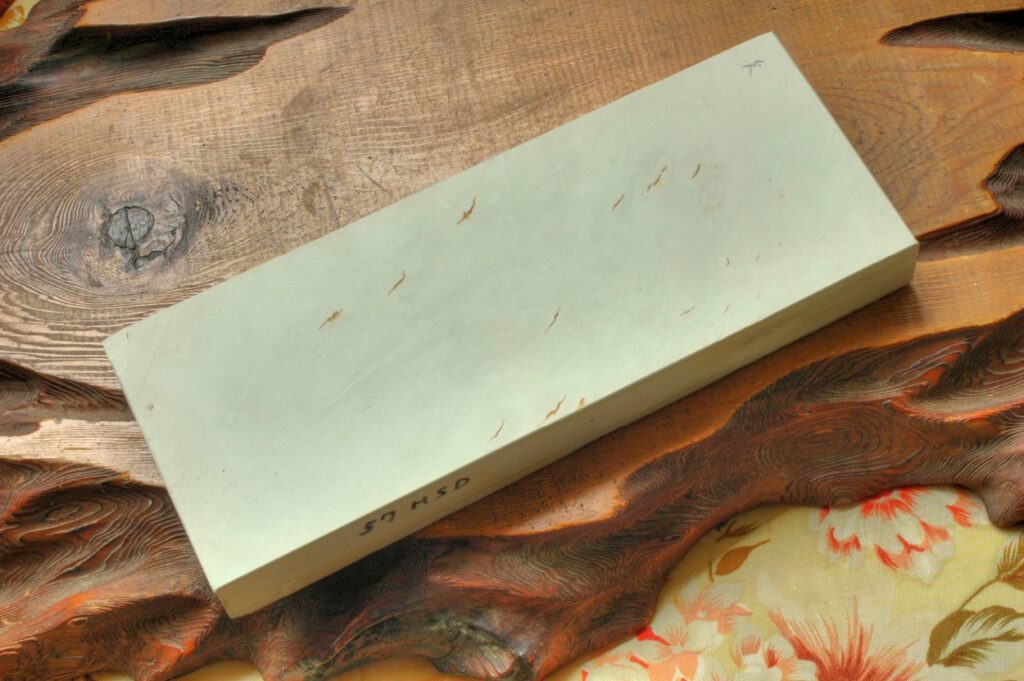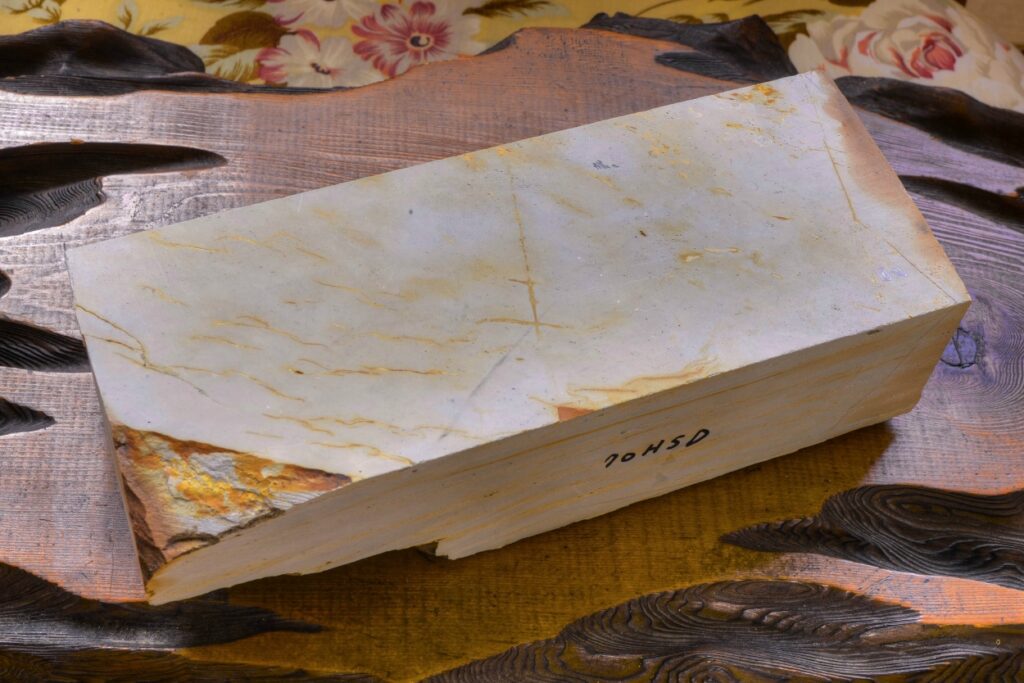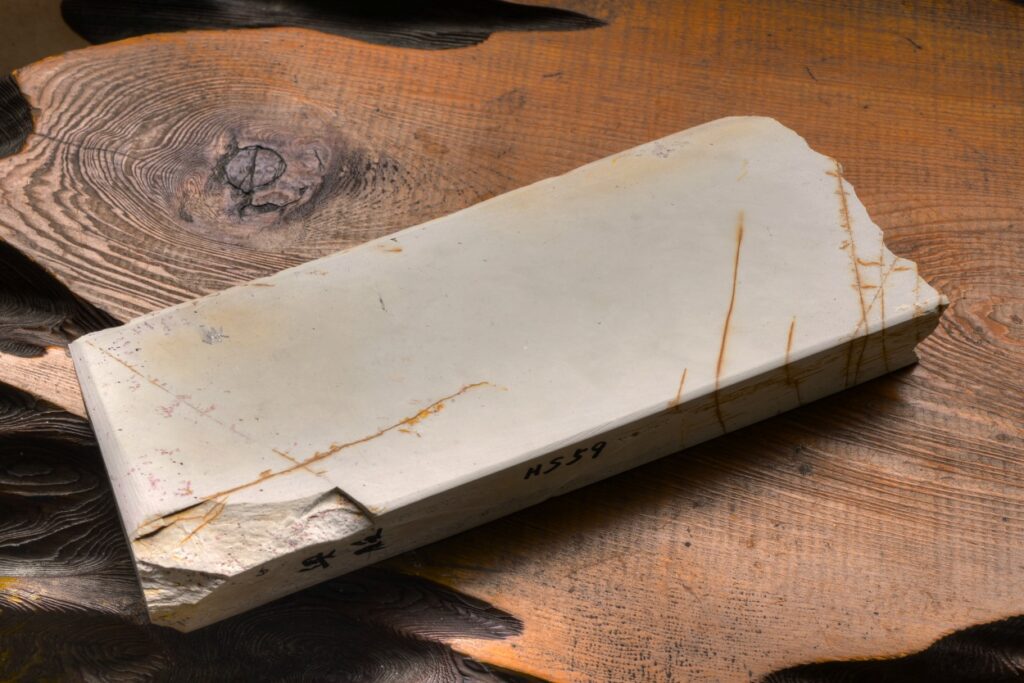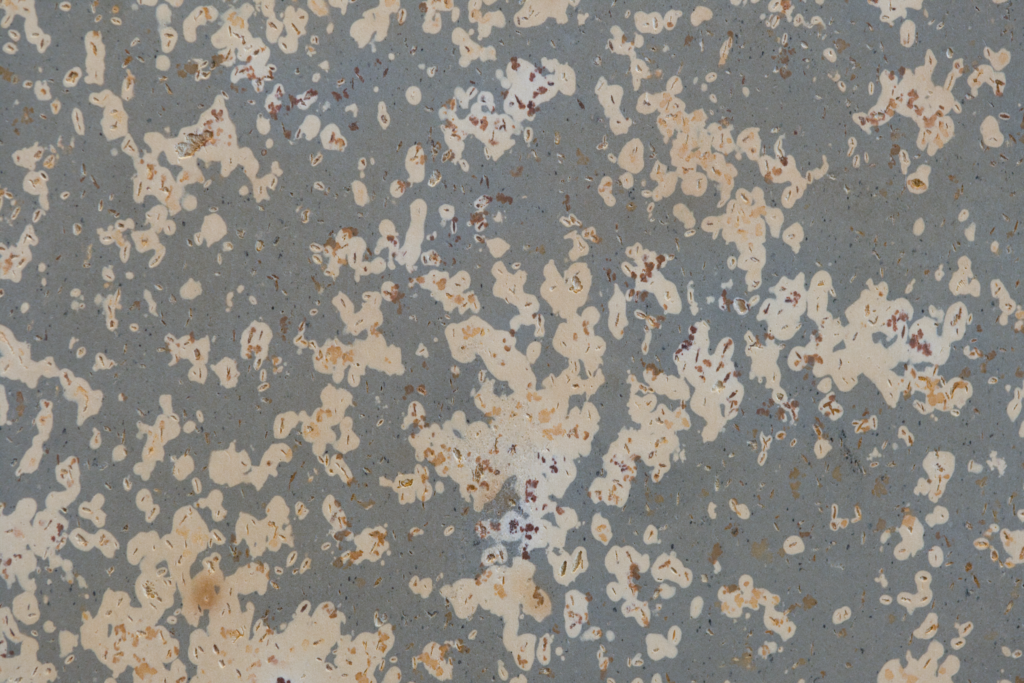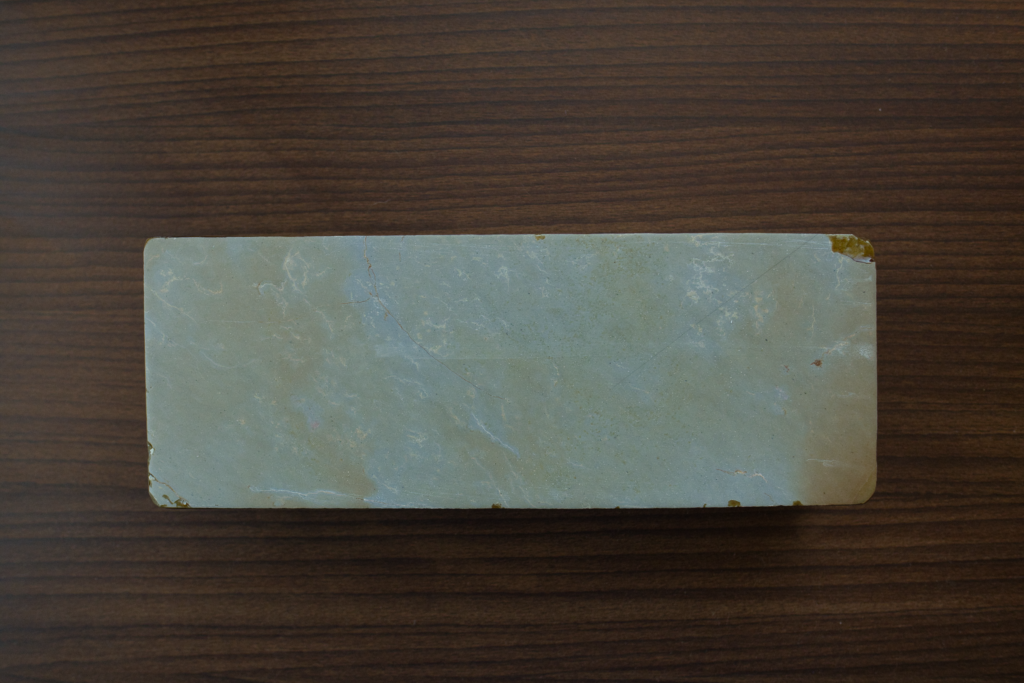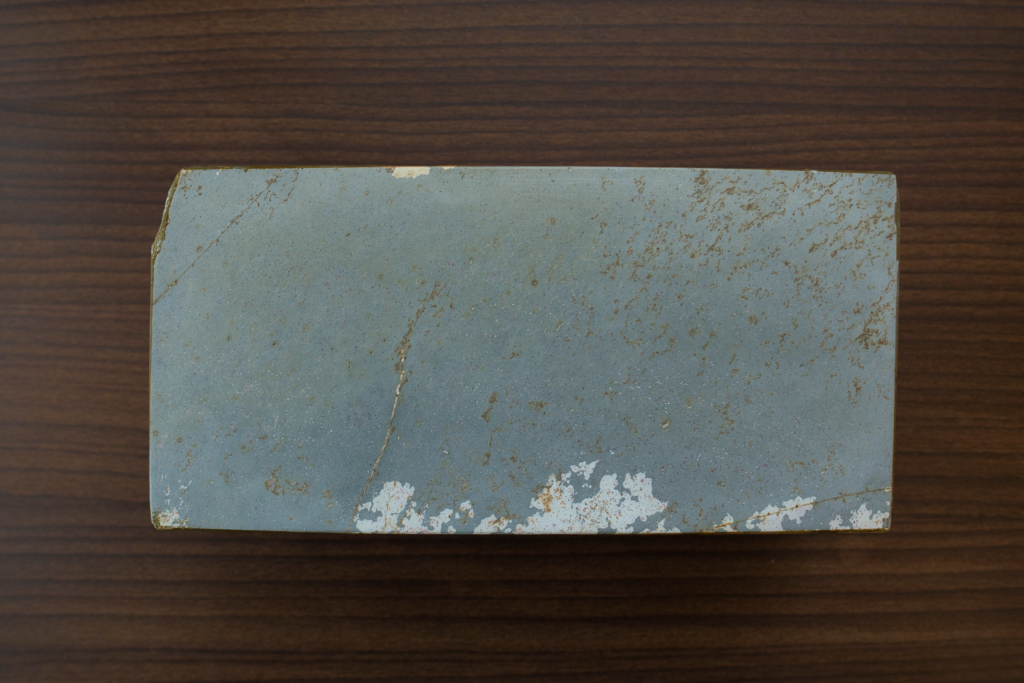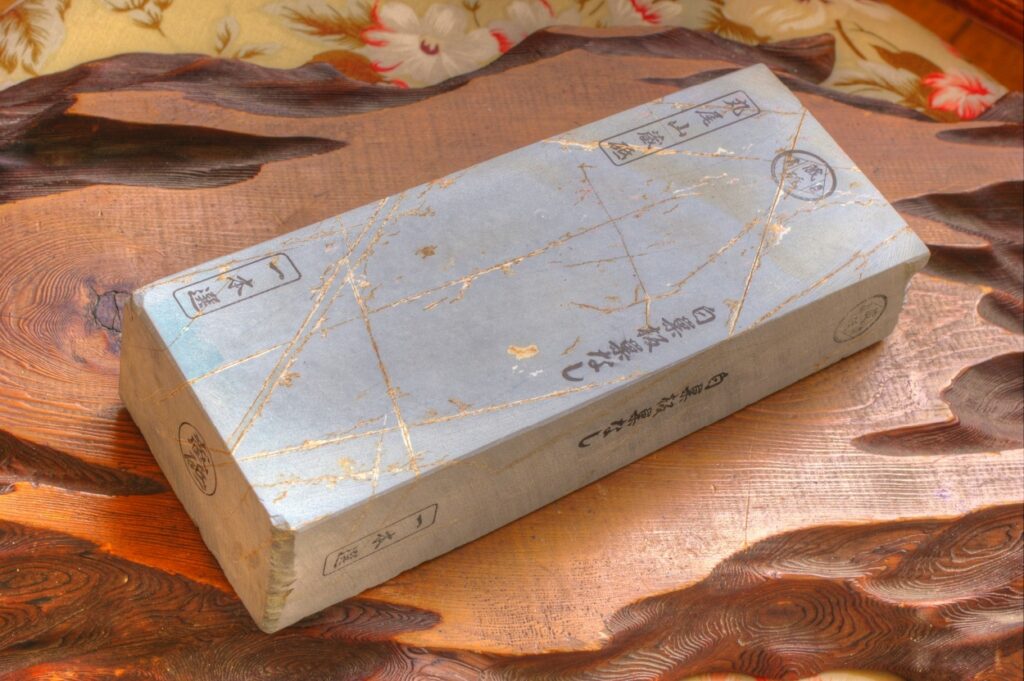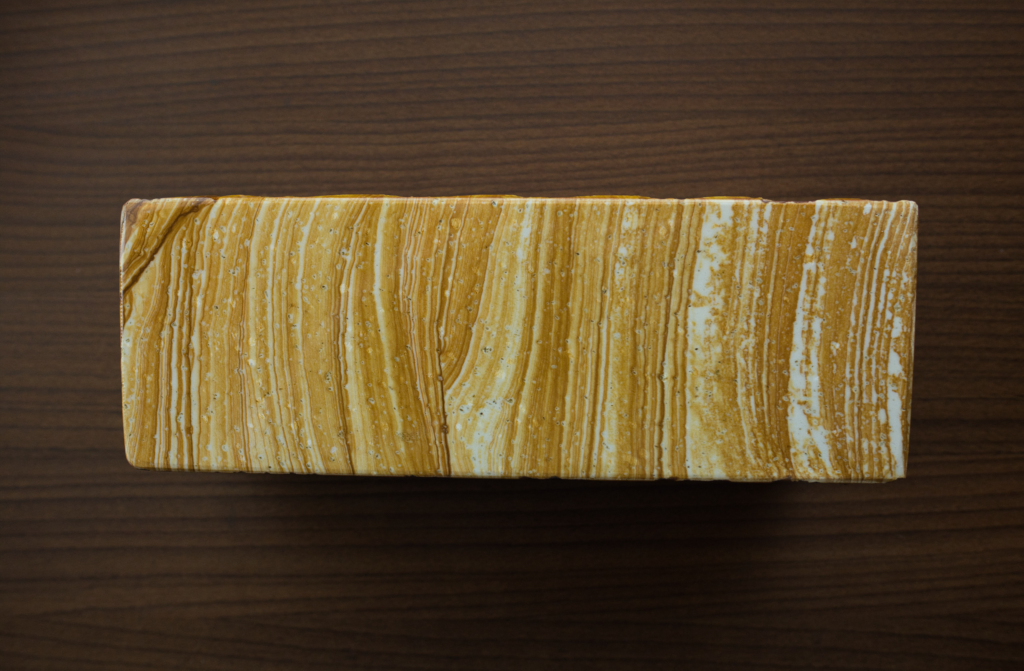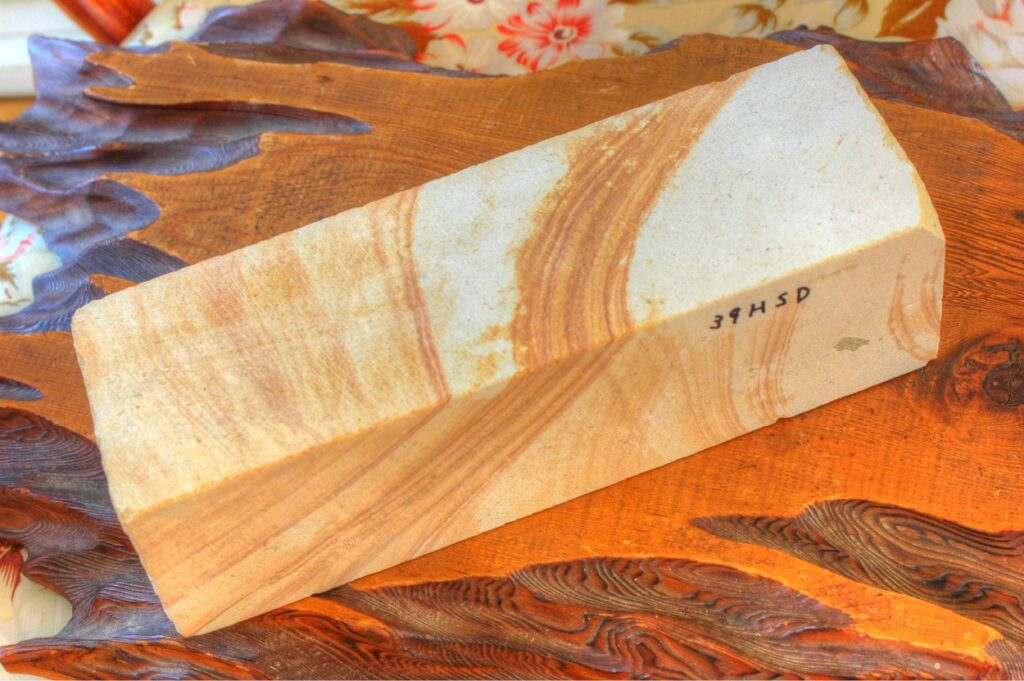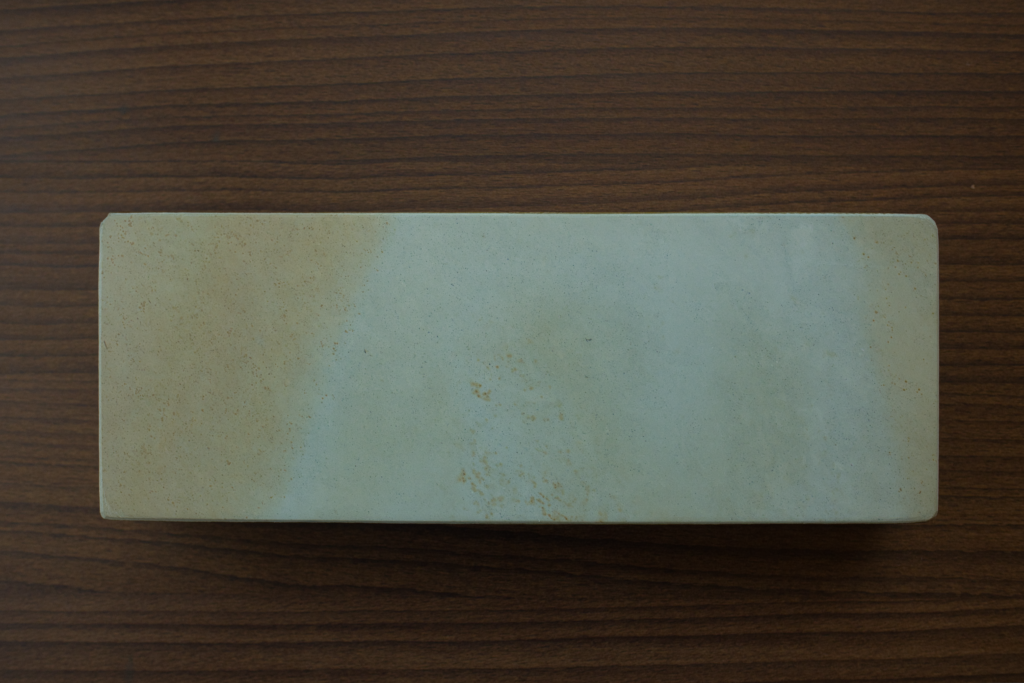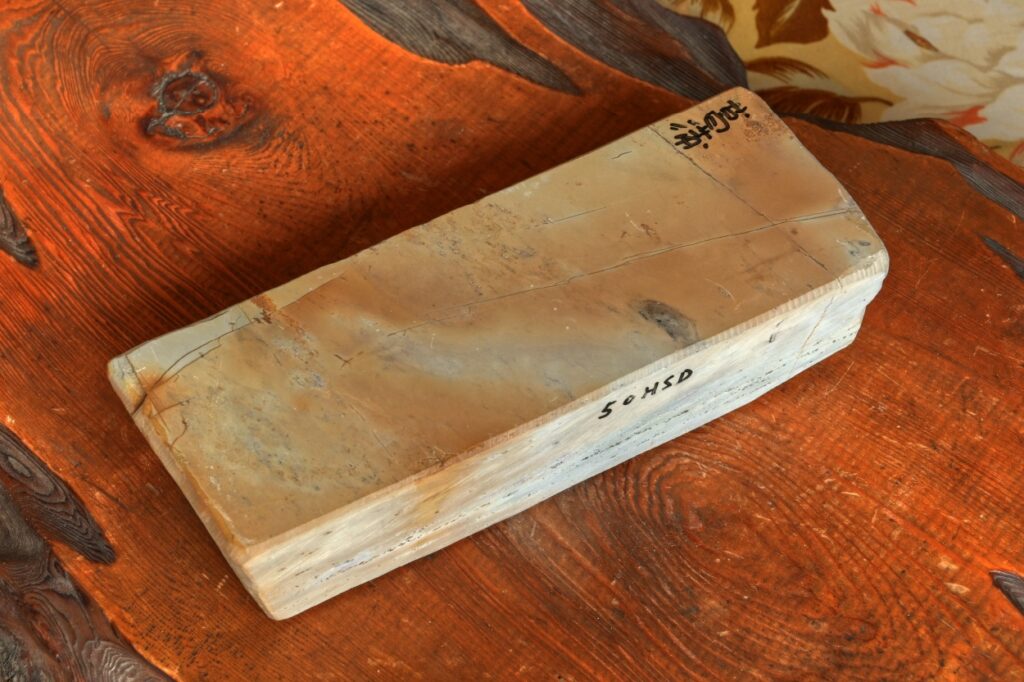Jnat Colors (Base)
Identifying JNAT colors usually starts with naming the underlying color of the stone and usually what color the slurry will be generated as. This does not stop the stone from having other coloring elements – most stones do.
Aka
Asagi
Iki Murasaki
Iromono
Karasu
Kiita
Kuro
Mizu / Mizu Asagi
Shiro
Tamagoiro
Torato
Uguisu
Jnat Colors (Additional), Patterns, or Terms
These attributes are *in addition to the base color*, so they will never (typically) describe the base color themselves but be an additional identifier of how the stone looks. Additional JNAT colors, patterns and terms span a wide range of looks and patterning as covered below:
Gotogi
Habutae
Kakishibu
Kan
Kawa
Keppan
Kiiro
Masame
Mokume
Namazu
Nenrin Hada
Su
Sunashi
Tamamoku
Yake
Inclusions Terminology (Safe)
These attributes are *in addition to base color and additional colorings/patterns/terms*. They are not really a form of JNAT colors, but fall within the same definition spectrum. Inclusions in the stone were made by some foreign material being embedded within sediment at the time of the stone’s creation. Many visual attributes are actually a form of inclusion. The majority of inclusions are either softer than the base stone or take on the attributes of the base stone and cause no issue. Toxic inclusions are the type that cause issue, often (and incorrectly) people will use the term “Inclusions” to refer to only “Toxic Inclusions”.
Atarazuno Hari
Enshou
Goma
Kesuji
Nashiji
Renge
Shikiutigumori
Suji
Sujimono
Suminagashi
Inclusions Terminology (Toxic)
JNAT Colors Example
- Base Color: Tamagoiro
- Additional Colorings, Patterns, or Terms: Masame
For additional information on labeling such as strata, mine origin, and weight you can find more here.
Aka – 赤
Red. Sometimes used interchangeable with Akapin when referring to the coloring of the stone, though since Akapin is a stratum that can be confusing. When referring to the coloring of the stone, it indicates deep red and pink colors throughout the stone or of the stone entirely. Not to be confused with Iromono or Keppan.
Asagi – 浅葱 orアサギ or 浅葱色 or 浅黄
This color indicates a very light/thin colored indigo, almost neutral grey base colored stone. Often mistranslated as shallow yellow or light yellow. This is a color that is attributed to grey whetstones. This is the sometimes incorrectly used as a catch-all term for anything which isn’t a vibrant yellow or white which is an incorrect use of it. Sometimes it can be hard to tell if a stone is Kiita, Tamago, or Asagi. When the stone is wet, it should turn darker and blue/grey, and the slurry should be grey/white colored.
![Jnat Colors - Asagi Colored Whetstone Japanese Natural Stone Whetstone JNAT
Credit: Jonathan Gwee [La Casa De Toshi]](https://naturalwhetstones.com/wp-content/uploads/2023/02/Nakayama-Asagi-1-1024x773.jpg)
Credit: Jonathan Gwee [La Casa De Toshi]
Atarazuno Hari – 当たらない針
The presence of thin black lines or dots which are sometimes but not always reflective. See Harike for the toxic variety.
Enshou – 煙硝
A term for firecrackers in Japanese. Unlike Ao Renge or Kuro Renge (黒蓮華), this term is used to refer to black dendrite formations within the whetstone when we are referring to non-Suita stones. These formations are almost always non-toxic.
Gotogi – 合砥
This refers to the visual layering seen on the side or surface of the whetstone. This visual formation is the result of where sedimentary silt piled on top of one another from ocean or geological currents and pressed them together. When the Gotogi quality is ontop of the stone it can also be referred to as Masame.
![Jnat Colors - A Japanese Natural Stone Whetstone JNAT with Gotogi, visible layering, on the sides.
Credit: Jonathan Gwee [La Casa De Toshi]](https://naturalwhetstones.com/wp-content/uploads/2023/02/Ozuku-Karasu-Side-1-1024x666.jpg)
Credit: Jonathan Gwee [La Casa De Toshi]
Goma – 胡麻
A term for sesame (seeds) in Japanese. When used for whetstones it indicates the presence of black dots within the stone’s formation, though these dots can take a variety of shapes from small lines, blotches, to round circles. This is typically considered a non-toxic quality in stone
Habutae – 羽二重
This term is used to indicate an extremely white and pure Suita stone which looks to have a silken feature to it. This is a very rare and sought after visual quality in Suita stones.
![Jnat Colors - A more tannish example of a Habutae Awasedo japanese natural stone whetstone jnat
Credit: Jonathan Gwee [La Casa De Toshi]](https://naturalwhetstones.com/wp-content/uploads/2023/02/Ozuku-Habutae-Suita-1024x723.png)
Credit: Jonathan Gwee [La Casa De Toshi]
Harike
The toxic version of Atarazuno Hari, this is the presence of thin black lines or dots which are almost always reflective.
Iki Murasaki – いきむらさき
Purple-ish. It is an uncommon color of Maruoyama stones, commanding a higher price.
Iromono – 物
A term indicating colorful fabrics in Japanese. This characteristic shows as abstract splashes of color; red, pink, violet and possibly other colors mixed in as well. This is seen most often in softer Kiita stones. Not to be confused with Aka where red is the only color besides the base stone coloring.
Kakishibu – 柿渋
Named after a traditional dying method using discoloration caused by the oxidation of fermented juice. It is a visual quality to certain stones characteristically identified as a whiteish background color with circular or round blotches throughout in a light to dark brown variety. This pattern can form the look of droplets or standing water on the surface of the white background. Most common in Suita stones.
Kan or Kanmaki – 環巻
This term means Ring Roll in Japanese. A visual pattern in the stone which mimics the rings of a tree. This can be easily confused with the Mokume, Nenrin Hada, or Torato qualities of a stone.
Kanesuji
This is an often reflective (but not always) hairline inclusion which is “toxic” to the blade. Typically these lines are made up of a mineral inclusion which is harder than the surrounding stone and can be felt by the finger or as the blade is moved over it. Care must be taken to check all line as when a stone is freshly lapped flat it is possible for Kanesuji to not be felt by the finger/blade until the stone is used some. If you feel a line indicating Kanesuji, you can dig it out with a nail.
Karasu – カラス or 烏
A term meaning crow in Japanese. This is a blue/black/white pattern in the stone which resembled crows in flight within a darkening sky and come from the Aisa layer of the Hon-Kuchi Naori Strata. Care must be taken with these stones as the dark “crow-like” spots can sometimes be toxic to the blade and must be tested. Often these stones can also include Kanesuji lines which should also be tested for. Light Karasu stones free of lines are highly prized and valuable.
![Jnat Colors - A Japanese Natural stone Whetstone JNAT with a darker Karasu pattern
Credit: Jonathan Gwee [La Casa De Toshi]](https://naturalwhetstones.com/wp-content/uploads/2023/02/Shoubudani-Karasu-1024x817.png)
Credit: Jonathan Gwee [La Casa De Toshi]
Kawa – カワ
The “skin” of a whetstone, the hard natural outer surface of raw sediment. Kawa is often referred to as a very hard outer surface, but some stones can have a soft enough one to work away with water and your finger. It depends greatly on the mine it was pulled from, and very experienced users can estimate a stone’s origin from how the Kawa acts/looks.
![Jnat Colors - Awasedo Japanese Natural Stone Whetstone JNAT Kawa behind a layer of Lacquer for protection
Credit: Jonathan Gwee [La Casa De Toshi]](https://naturalwhetstones.com/wp-content/uploads/2023/02/Hideriyama-Renge-Suita-Kawa-2-819x1024.jpg)
Credit: Jonathan Gwee [La Casa De Toshi]
Keppan -血斑
Blood Spots. This is a visual moniker for stones which have blotches of red swirls within them which looks like pooled or running blood. As with most red coloring (Aka, Iromono, etc.) this is most commonly found in Kiita or Tamagoiro stones.
Kesuji – 毛筋
Hairline inclusions which usually show as black or brown on the surface of a stone but are not felt under the finger or blade. Not to be confused with Suji which is a different formatoin in the stone. Kesuji can sometimes swell with soaking in water and crack along the line, so care must be taken with stones which have deep or plentiful Kesuji lines. It is possible but not common for Kesuji lines to become Kanesuji in different parts of the stone, so hairline inclusions should be frequently retested especially when polishing.
Kiita – 黄板
A term meainng yellow plate in Japanese. These stones will be a vibrant or dark yellow throughout the base coloring of the stone as well as when the stone is slurried. The Kiita coloring can often indicate that the stone will be softer but that is not a firm rule. This is not to be confused with Tamagoiro which is a related and similar looking color. Often the difference between the two can be conclusively decided by looking at the slurry’s coloring rather than that of the stone itself.
Kiiro – 黄色
Yellow/Amber. Usually used to identify qualities of a stone but not the whole stone itself, otherwise it would be noted as Kiita.
Kuro – 黒
Black. Usually used as a stone characteristic for Tsushima or other primarily black whetstones.
Masame – 柾目
A term meaning straight grain in Japanese. This is the resulting visual look when a stone is cut with the Gotogi layering on the sharpening surface of the stone rather than the more usual side orientation. This does not negatively impact performance of the stone and is simply a name for the look/style of cut.
Mizu Asagi – 水浅黄
A term meaning light blue water in Japanese. Usually, this term is used to describe a blue/grey color that is reminiscent of shallow ocean water. The color can also be greenish as well and is formed between Asagi and Kiita layers. These stones typically have a high percentage of grit within them, resulting in the white of the silica the mixing with the grey (Asagi) and yellow (Kiita) creating the color.
Mokume – 木目
Wood Grain. A pattern that resembles the grain found in wood. The difference between this and Kan is difficult to tell. This should be less layering across the stone and more of a pattern within it.
Momiji – 紅葉
This team means autumn leaves in Japanese. This is a visual term indicating the look of colorful blotches of renge which are akin to fallen autumn/fall leaves on stone. Typically for this term to apply you should see multiple different colors of renge mixed together blanketing the stones surface. It doesn’t have to be different colored renge though, their density is more what it is referring to. I’ve been told that this term can also be used to refer to singular orange renge rather than a pattern – given that the already used name “renge” ranges in colors of pink/orange/blue/black/etc it seems like a misuse of this term to me – but if a stone isn’t covered in renge but is for some reason using the name “Momiji” still – perhaps this is what the vendor is trying to indicate to you. I use the term strictly to refer to the pattern though myself.
![Jnat Colors - An Awasedo japanese natural stone whetstone jnat with the leaf version of Momiji
Credit: Jonathan Gwee [La Casa De Toshi]](https://naturalwhetstones.com/wp-content/uploads/2023/02/momiji-915x1024.png)
Credit: Jonathan Gwee [La Casa De Toshi]
Namazu – なまづ or 癜
A term referring to the giant catfish of Japanese mythology responsible for creating earthquakes. When used with whetstones, it indicates a visual quality where white or very light tan marks in the form of spots, lines, nonuniform shapes are present in the stone.
Nashiji – 梨地 or なしじ
A term meaning pear-like in Japanese. This is a visual term indicating small brown spots or marks on the stone and looks very similar to a brown variant of Goma. These are non-toxic marks and do not impact performance of the stone.
Nenrin Hada – 年輪肌
This team means tree-ring skin in Japanese. It is used to describe a pattern within the stone that looks like the growth rings of a log of tree. The entire circle of the “log/tree” should be present or else this attribute is called Kan.
Renge – 蓮華
This term means lotus flower in Japanese. This is tiny freckling in the stone that can range in colors such red, orange, pink, purple, black and blue. Black and Blue Renge is often referred to as Kuro or Ao Renge. Not to be confused with Goma or Nashiji, which will be clearly dots rather than various shapes. These are non-toxic and do not impact the performance of the stone.
![Jnat Colors - An Awasedo japanese natural whetstone jnat with Pink Renge
Credit: Jonathan Gwee [La Casa De Toshi]](https://naturalwhetstones.com/wp-content/uploads/2023/02/Ohira-Renge-Suita-3-1024x768.png)
Credit: Jonathan Gwee [La Casa De Toshi]
![Jnat Colors - An Awasedo japanese natural whetstone jnat with Pink and Orange Renge
Credit: Jonathan Gwee [La Casa De Toshi]](https://naturalwhetstones.com/wp-content/uploads/2023/02/Ohira-Renge-Suita-1024x1006.jpg)
Credit: Jonathan Gwee [La Casa De Toshi]
Shiro – 白
White. Usually used to identify qualities of a stone but not the whole stone itself. This can get confusing when referring to White Suita stones as “Shiro Suita”. There is a stratum called Shiro Suita, but not all White Suita originate from it.
Su – 巣
A term meaning nest in Japanese. Su is a visual and structural classification to a stone where small holes are present in the formation of the stone. These holes were formed as gas moved through the sedimentary material as it was undergoing metamorphic changes, these escape routes creating small holes within the stones surface. This is most commonly found in Suita strata stones, however Tomae and other layers can infrequently have them present. If a stone has Su holes extra care should be taken if following a nagura progression as sediment from the nagura can get stuck in the hole and dislodge during later stages of your sharpening/honing/polishing progression.
Suji – 筋
A term meaning muscle in Japanese, this can sometimes be mistranslated as logic or streaks. This is a visual and structure quality to the stone which shows itself as brown lines running through the stone, often grouped together around layering divides. Not all Suji is safe to the blade, and stones with Suji present must be tested. Often the thicker the Suji line the more likely it is to be toxic.
Sujimono – 筋物
A term meaning muscle matter in Japanese. This term refers to a stone with a large amount of Suji present running throughout the stone. Sujimono stones are often considered undesirable stones due to the fact that Suji can be toxic.
![Jnat Colors - A Suita Awasedo Japanese Natural Stone Whetstone JNAT with Sujimono
Credit: Jonathan Gwee [La Casa De Toshi]](https://naturalwhetstones.com/wp-content/uploads/2023/02/Saga-Ohira-Renge-Shiro-Suita-1024x940.png)
Credit: Jonathan Gwee [La Casa De Toshi]
Suminagashi – 墨 流 し
A term meaning ink flow in Japanese. These stones have an ink on marble effect that is very beautiful and sought after. Often these are asagi stones with black lines/formations upon them, but the effect can be present with any color variation.
Sunashi – 巣なし
A term meaning no nest in Japanese. These are stones from one of the 3 strata of Suita which lack the common Su holes throughout its composition. Sunashi Suita stones have a reputation for being harder than Suita stones with Su present.
Tamagoiro -卵色 or Tamago – 卵
A term meaning egg colored in Japanese. These stones often look like a lighter less bright yellow version of Kiita, a yellow leaning tan base color such as a light-colored brown egg. Often it can be difficult to tell these apart from Kiita stones, but the slurry will often make it clear if it is Kiita or Tamagoiro. Tamagoiro stones tend to be softer.
Tamamoku – 玉目
A term referring to the tamamoku cedar in Japanese. This type of wood has circular burls running throughout it which creates a specific visual look. Tamamoku when referring to whetstones are stones with base coloring which mimic this cedar pattern. Stones with this coloring are often hard stones which are highly compressed.
Torato – 虎砥
A term meaning tiger whetstone in Japanese. This term refers to a whetstone which is red and color and has banded orange and/or white strips throughout, like that of a tiger. This is most commonly seen in Amakusa and Natsuya stones and tends to indicate superior grinding performance but at the expensve of relative fineness.
Uguisu – うぐいす
A color term used for Maruoyama stones indicating grayish green-brown ones which are mined in the Tomae layer.
Yake – 焼け or やけ
A term meaning burnt in Japanese. This can either refer to the entire stone itself, but more commonly to parts of the stone which appear to have been “burnt” and show as a deep orange color. This is a very common quality in certain Suita stones, specifically Okudo. The quality however can show in stones from any strata and is also frequently seen in Senmai stones. In rare cases Yake can be harder than the surrounding stone and as such a form of toxic, so it must be checked (the darker it is the more likely this is the case).
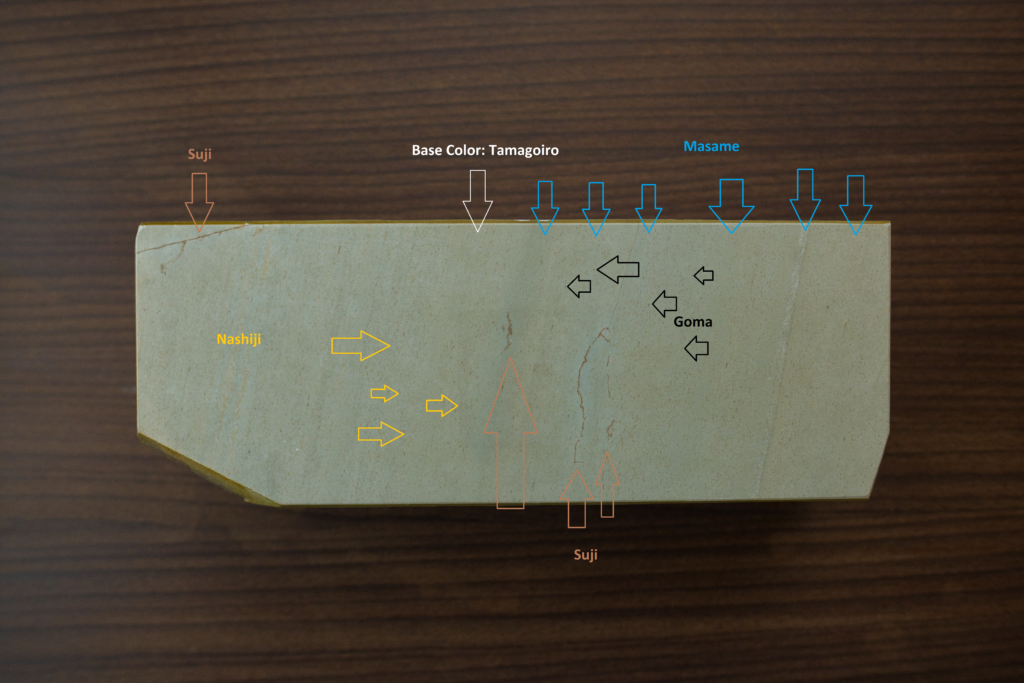
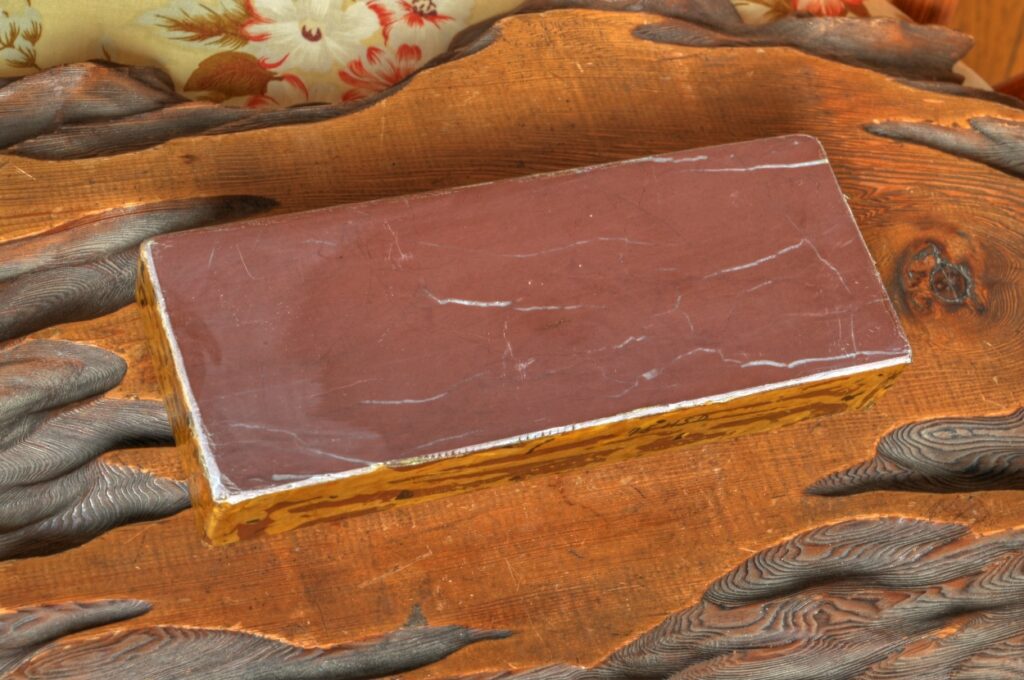
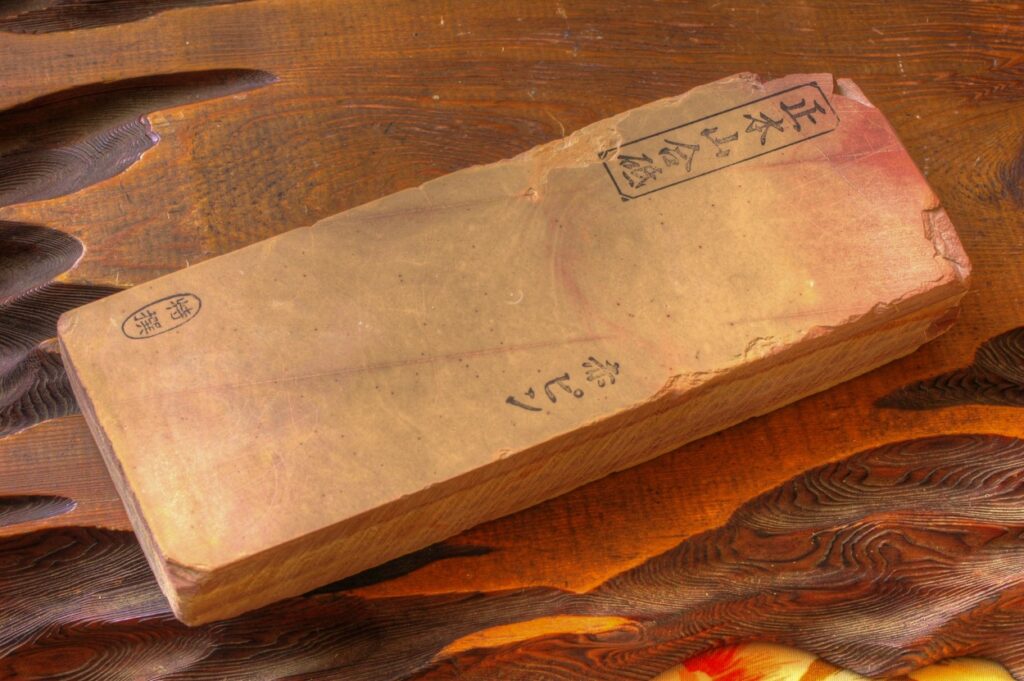
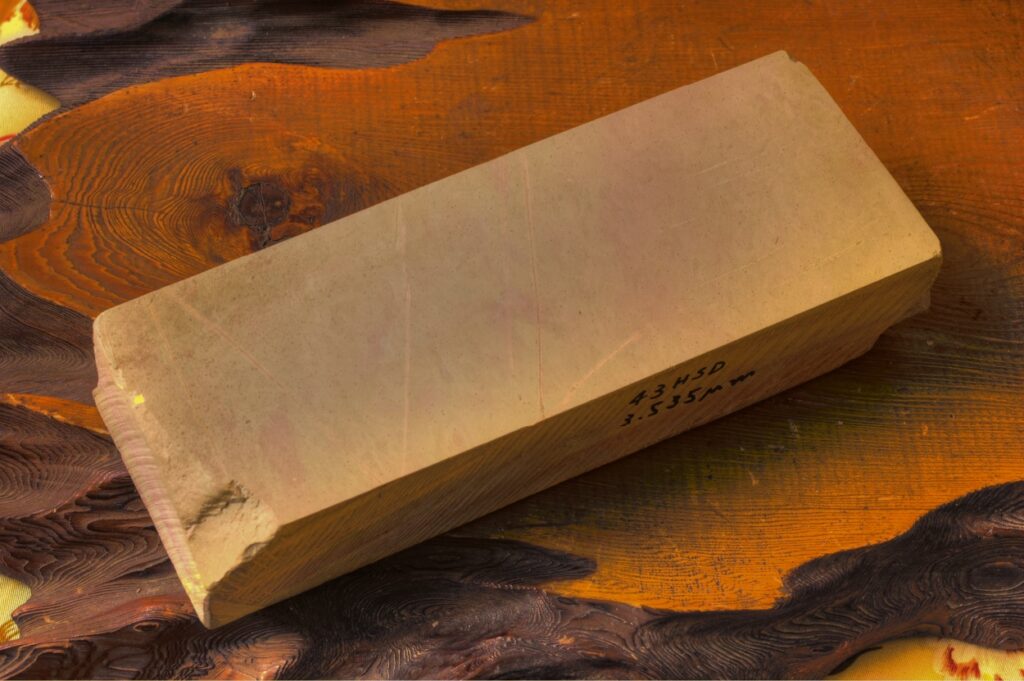
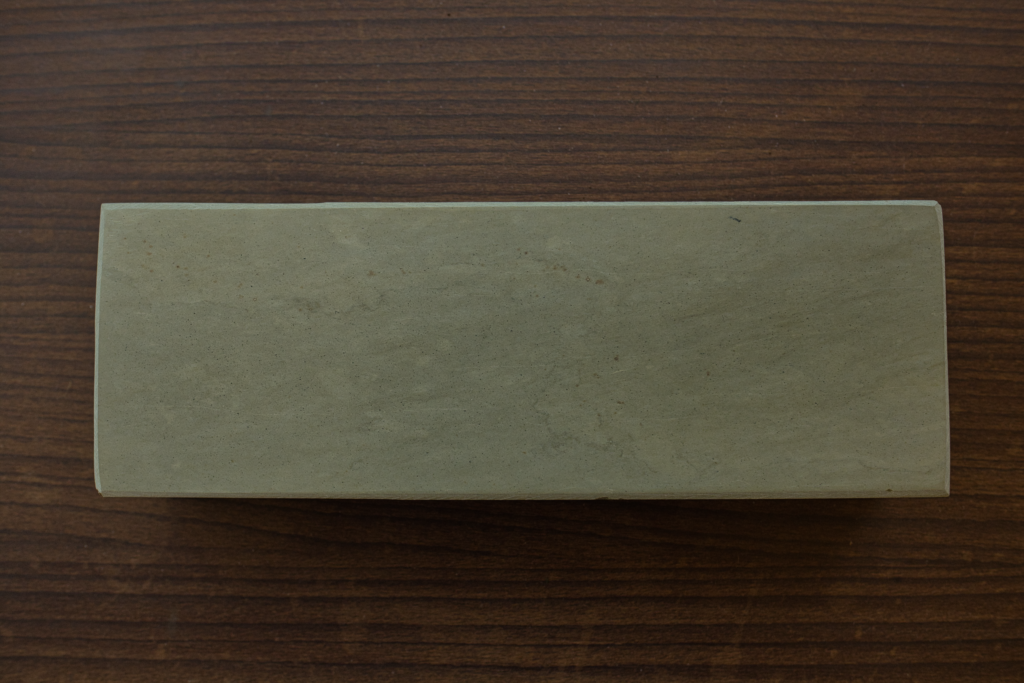
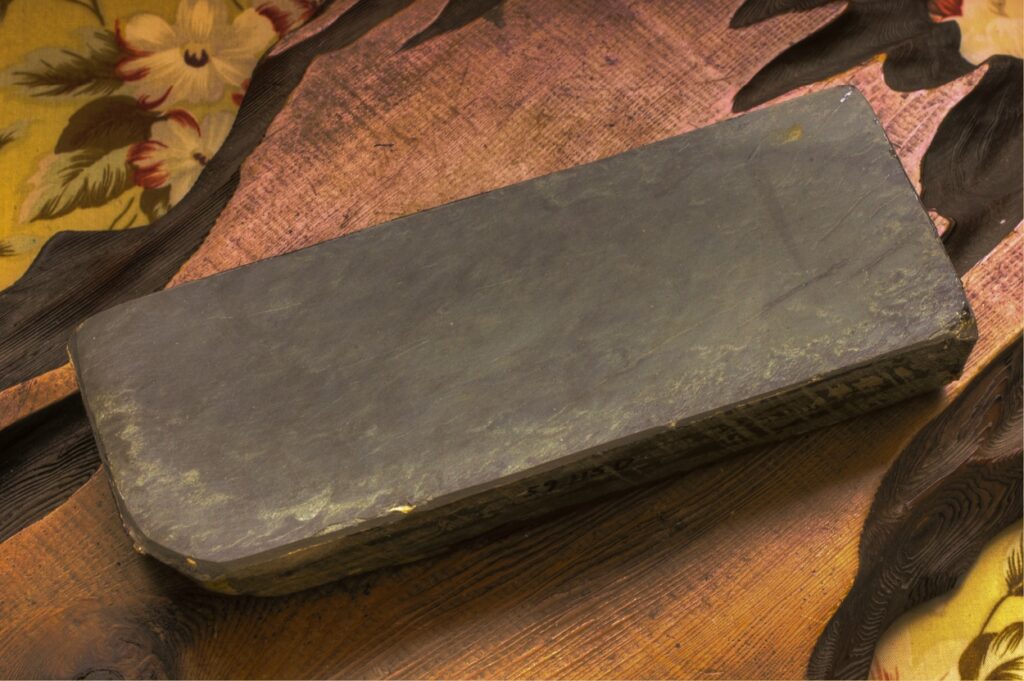
![Jnat Colors - Ohira Asagi Renge Suji Uchigumori Japanese Natural Stone Whetstone JNAT [Specifications]](https://naturalwhetstones.com/wp-content/uploads/2022/07/ohira-asagi-renge-suji-uchigumori-1024x681.png)
![Jnat Colors - An Ikarashi stone with Black Enshou Japanese Natural Stone Whetstone JNAT [Specifications]](https://naturalwhetstones.com/wp-content/uploads/2022/07/ikarashi-enshou-nakatoishi-wet-1024x683.png)
![Jnat Colors - A Southern Aizu with Black Enshou Japanese Natural Stone Whetstone JNAT [Specifications]](https://naturalwhetstones.com/wp-content/uploads/2022/07/aizu-enshou-nakatoishi-2-wet-1024x671.png)
